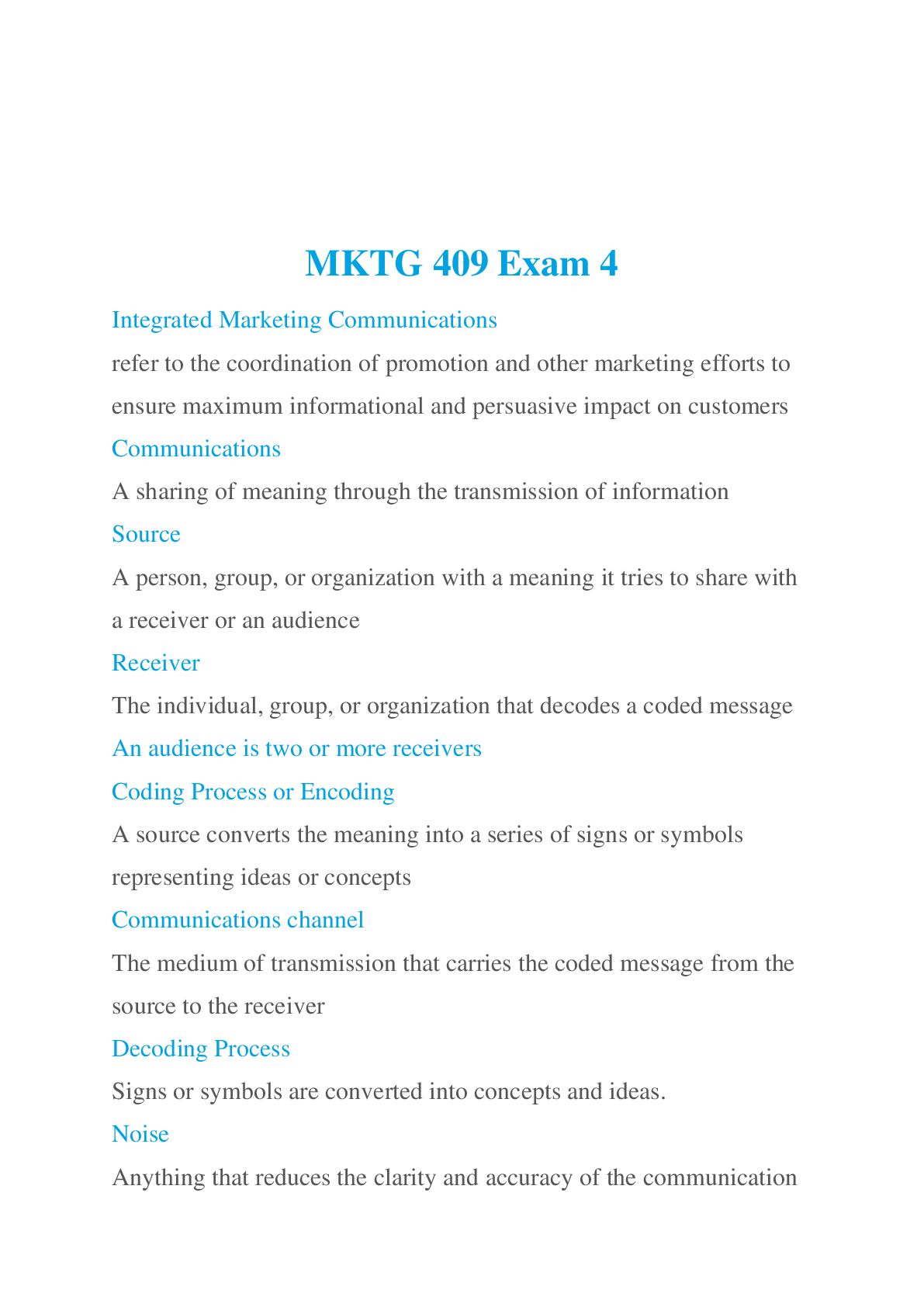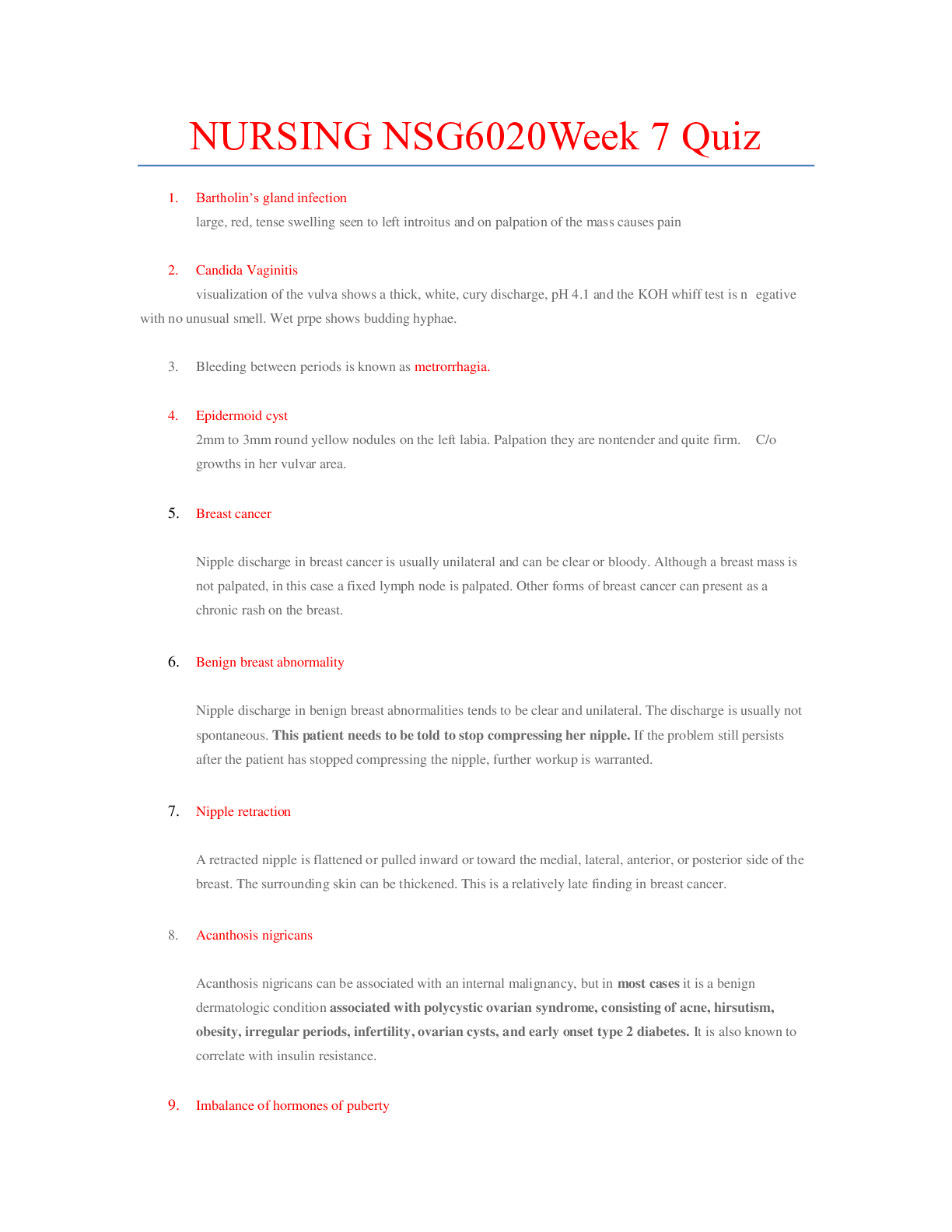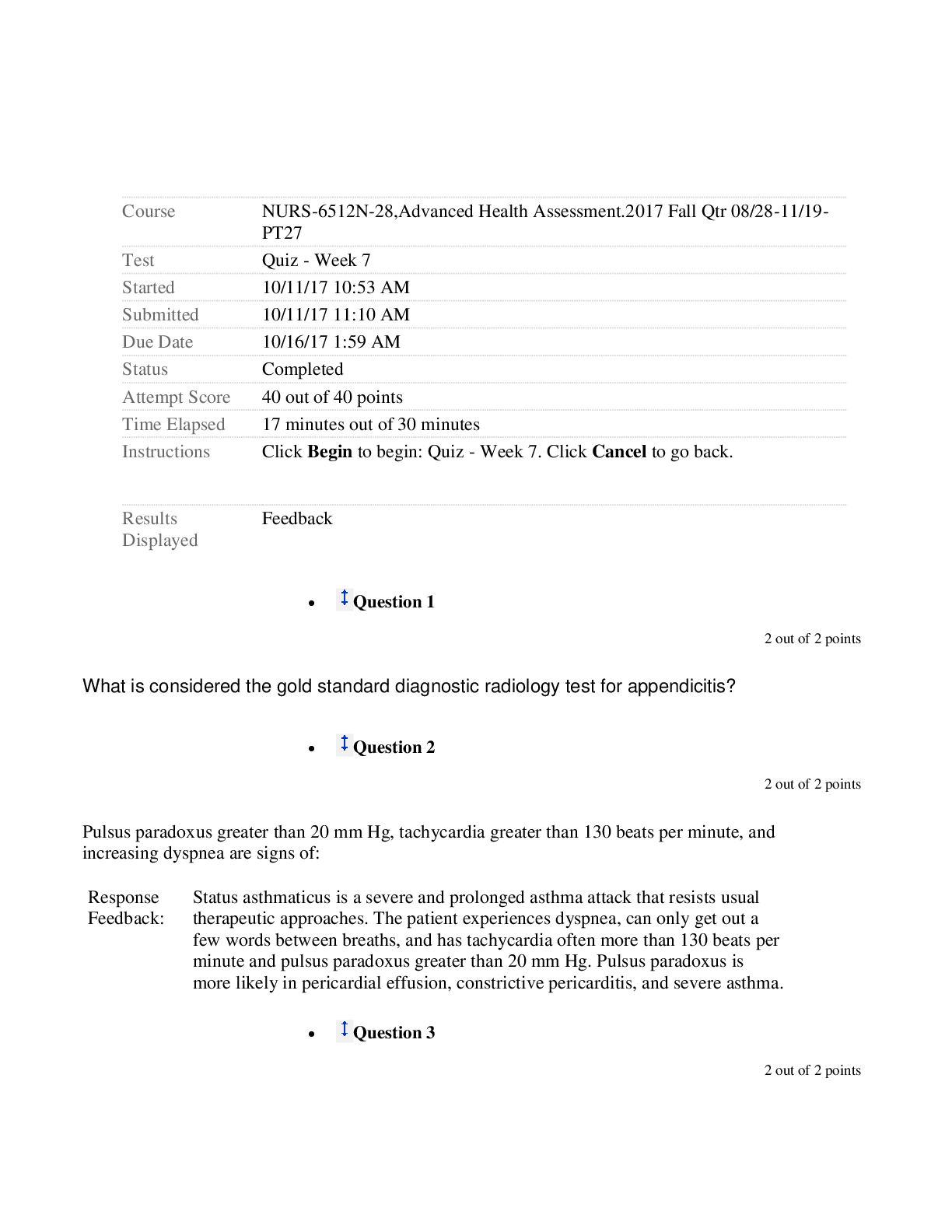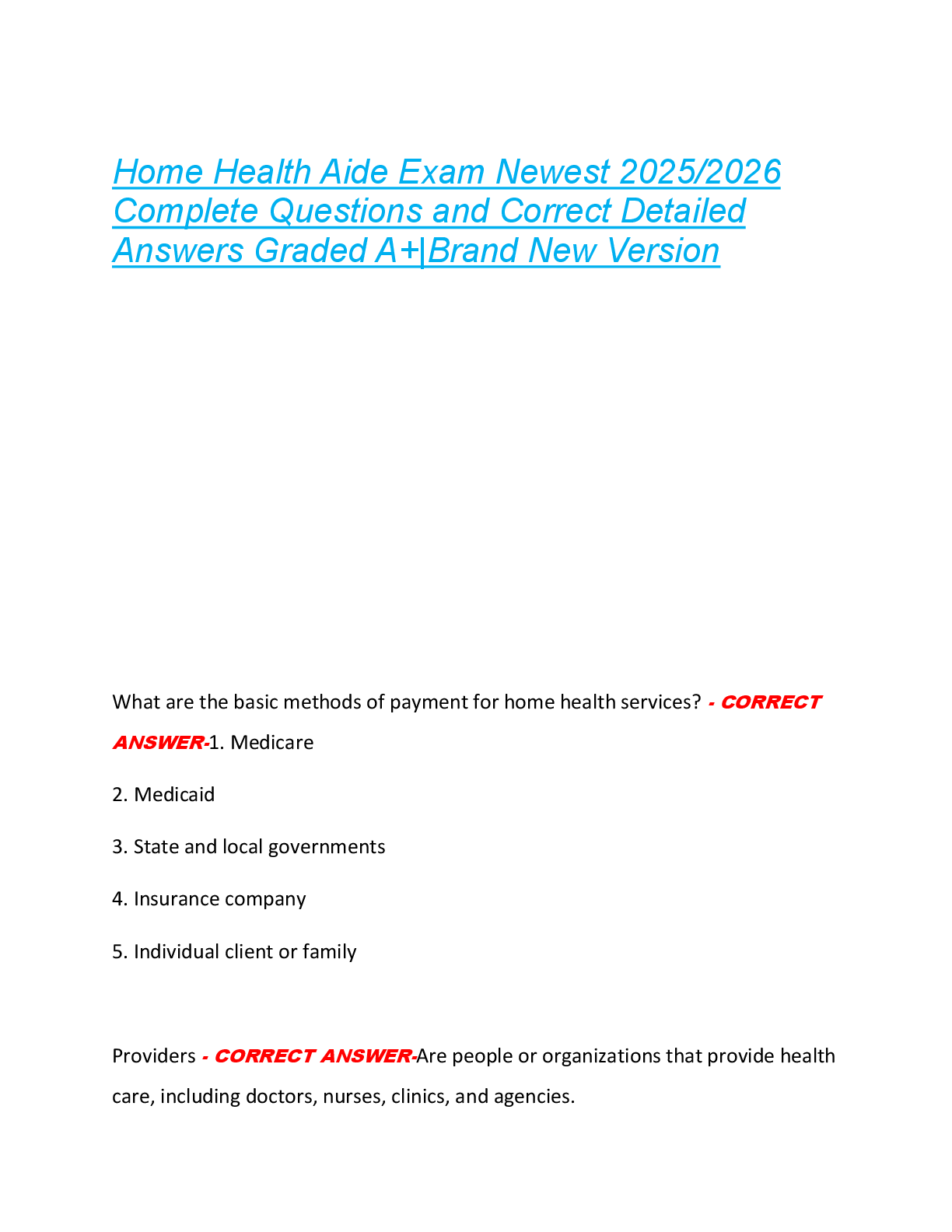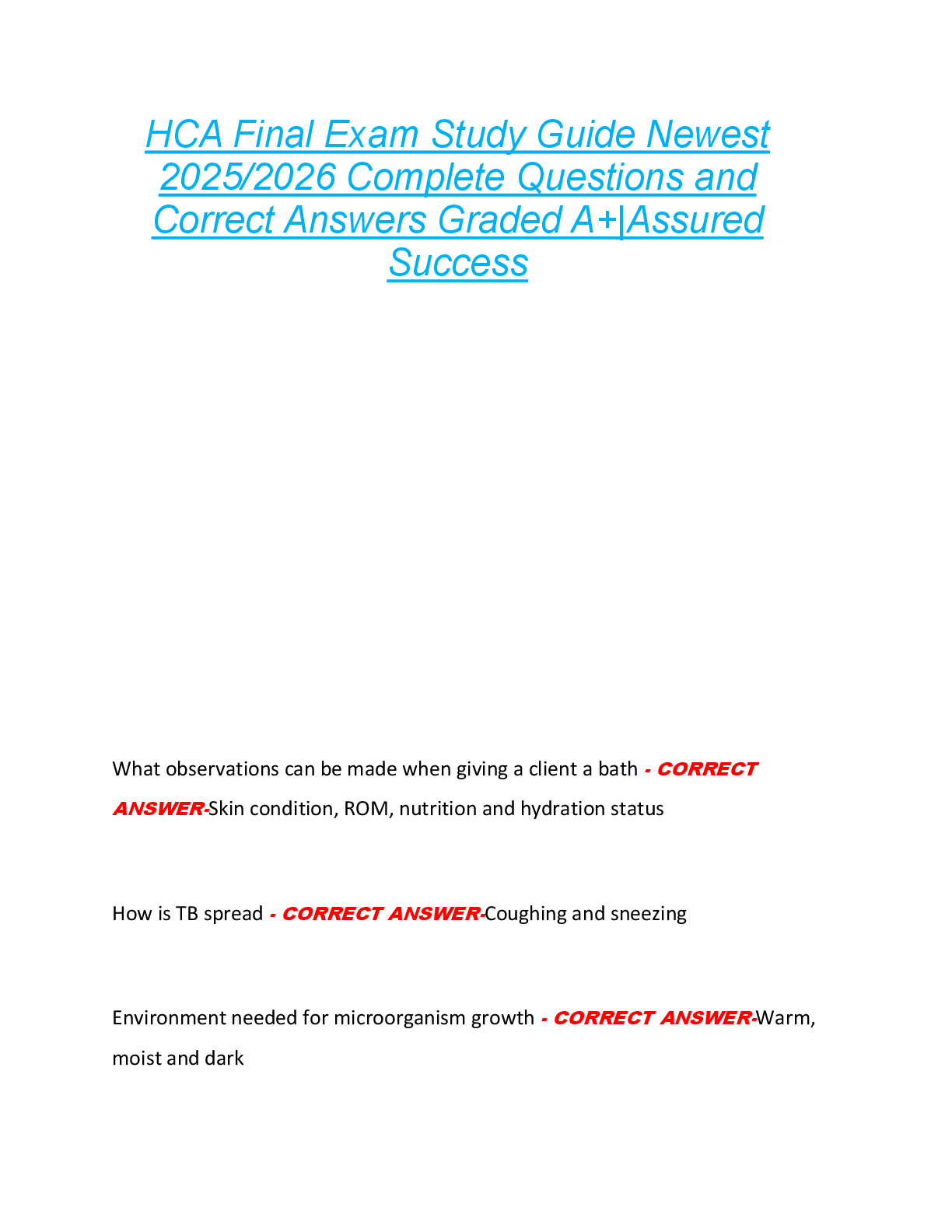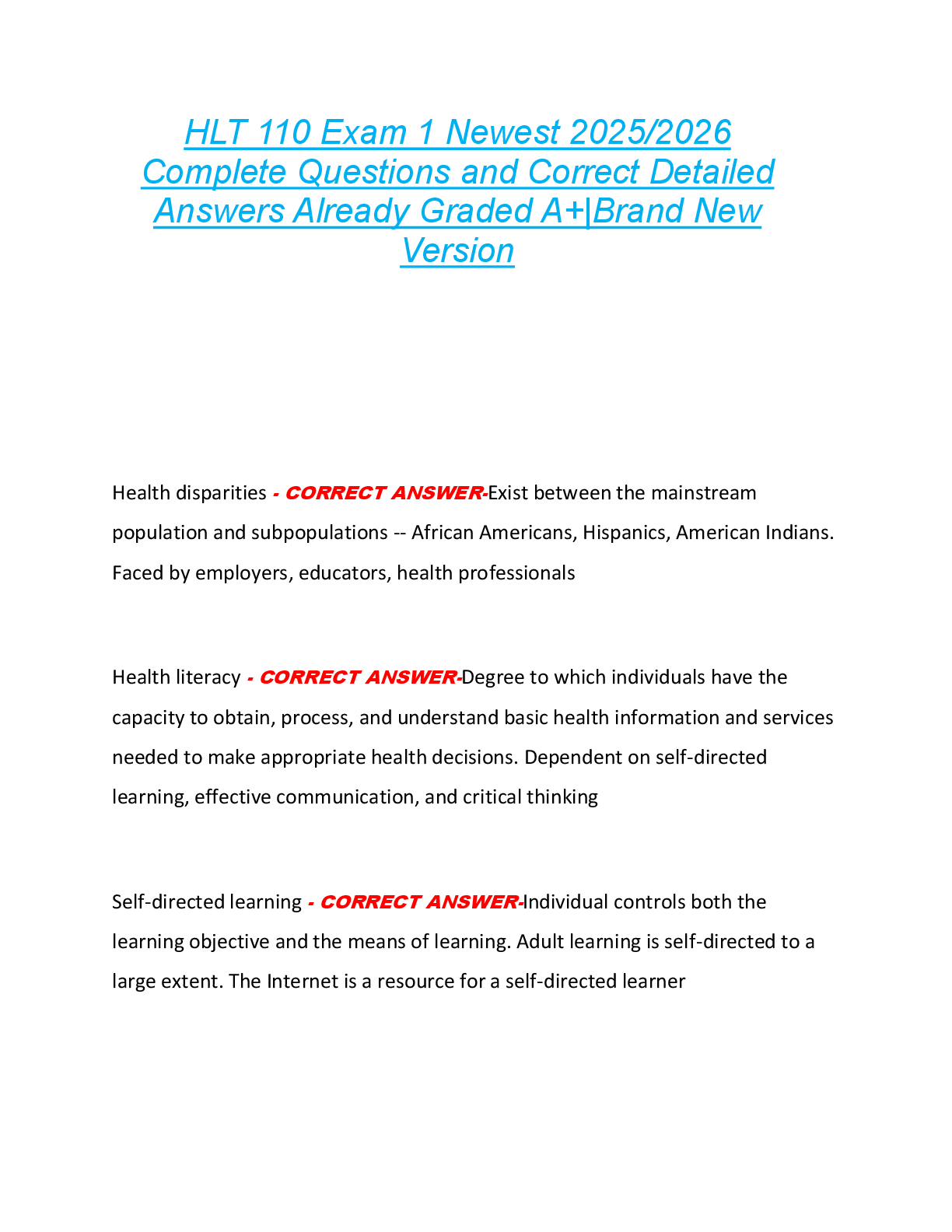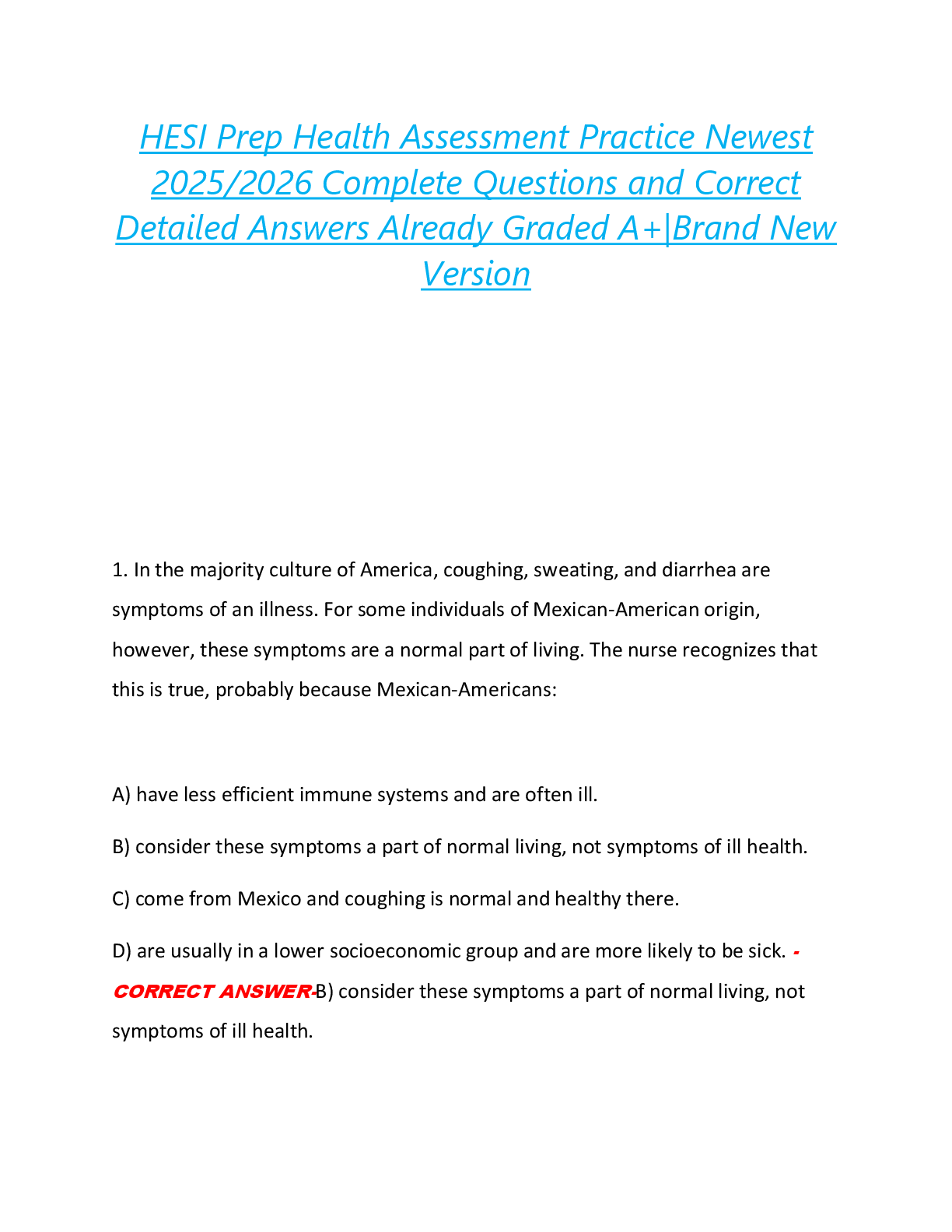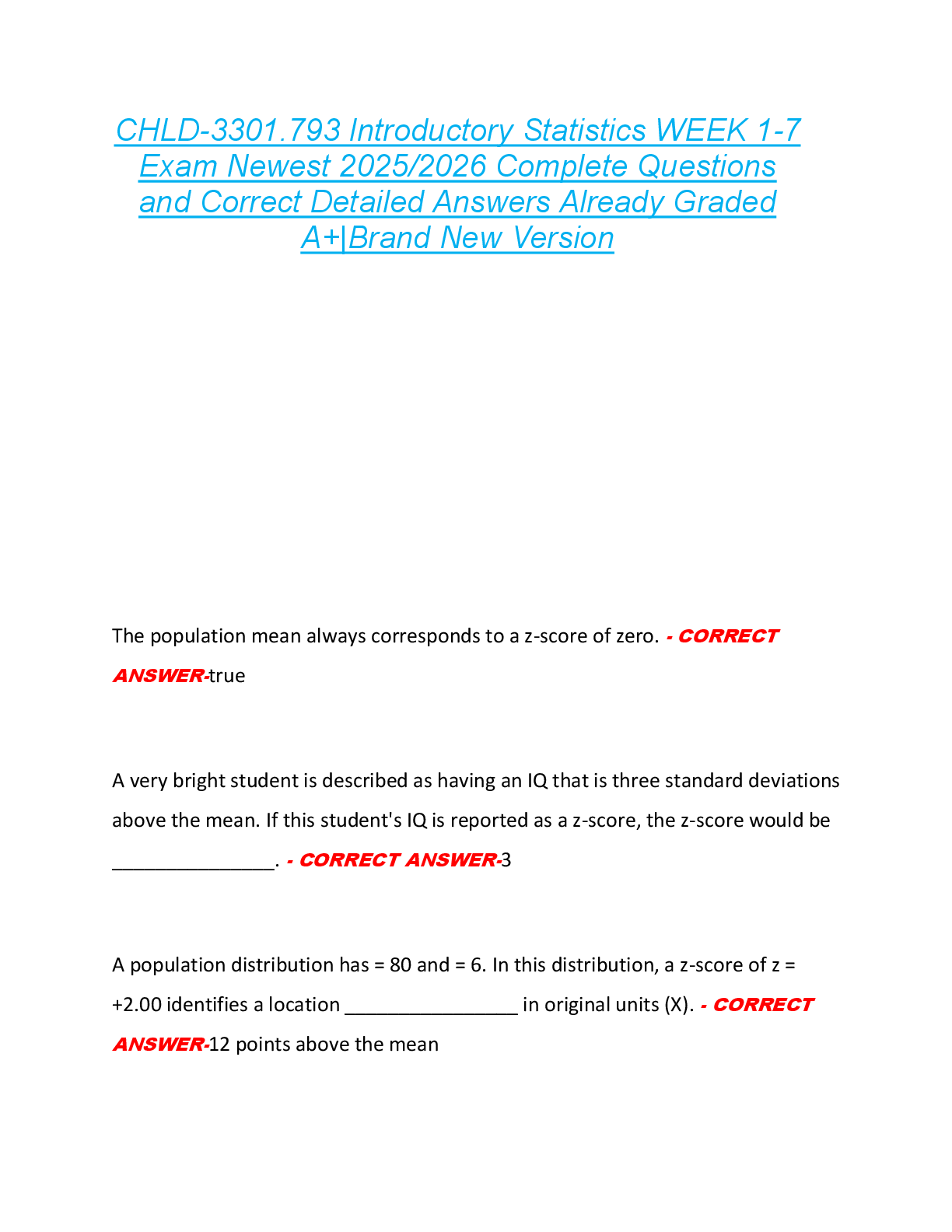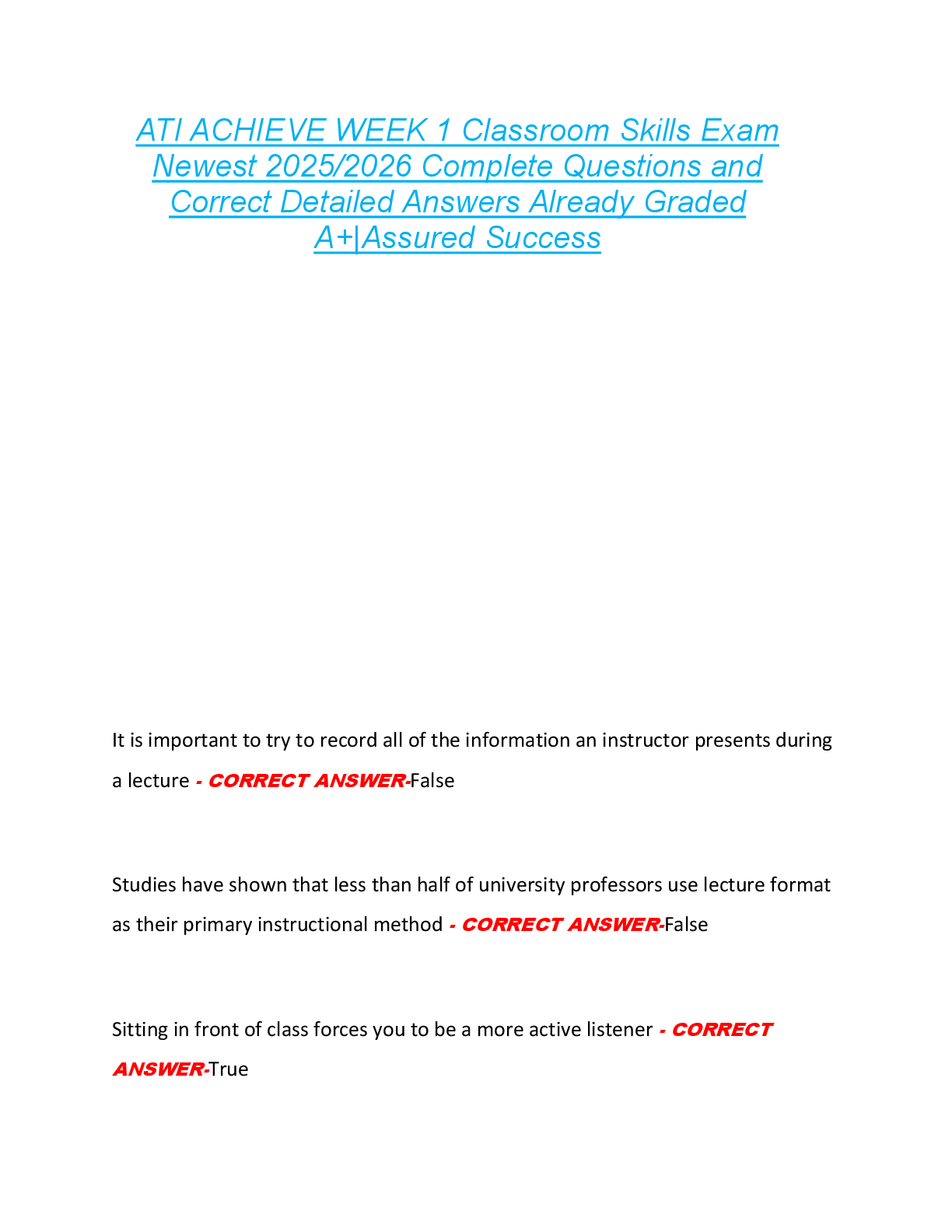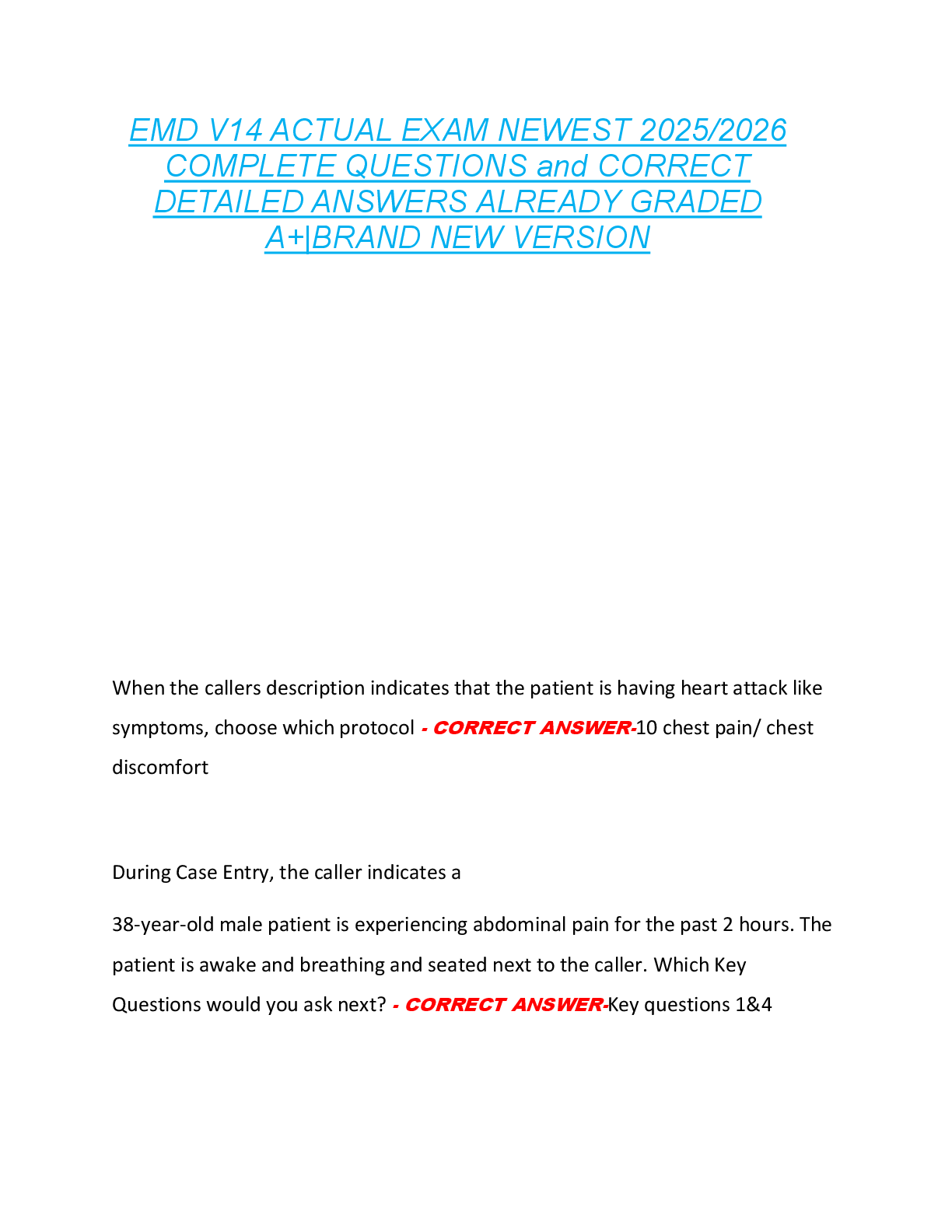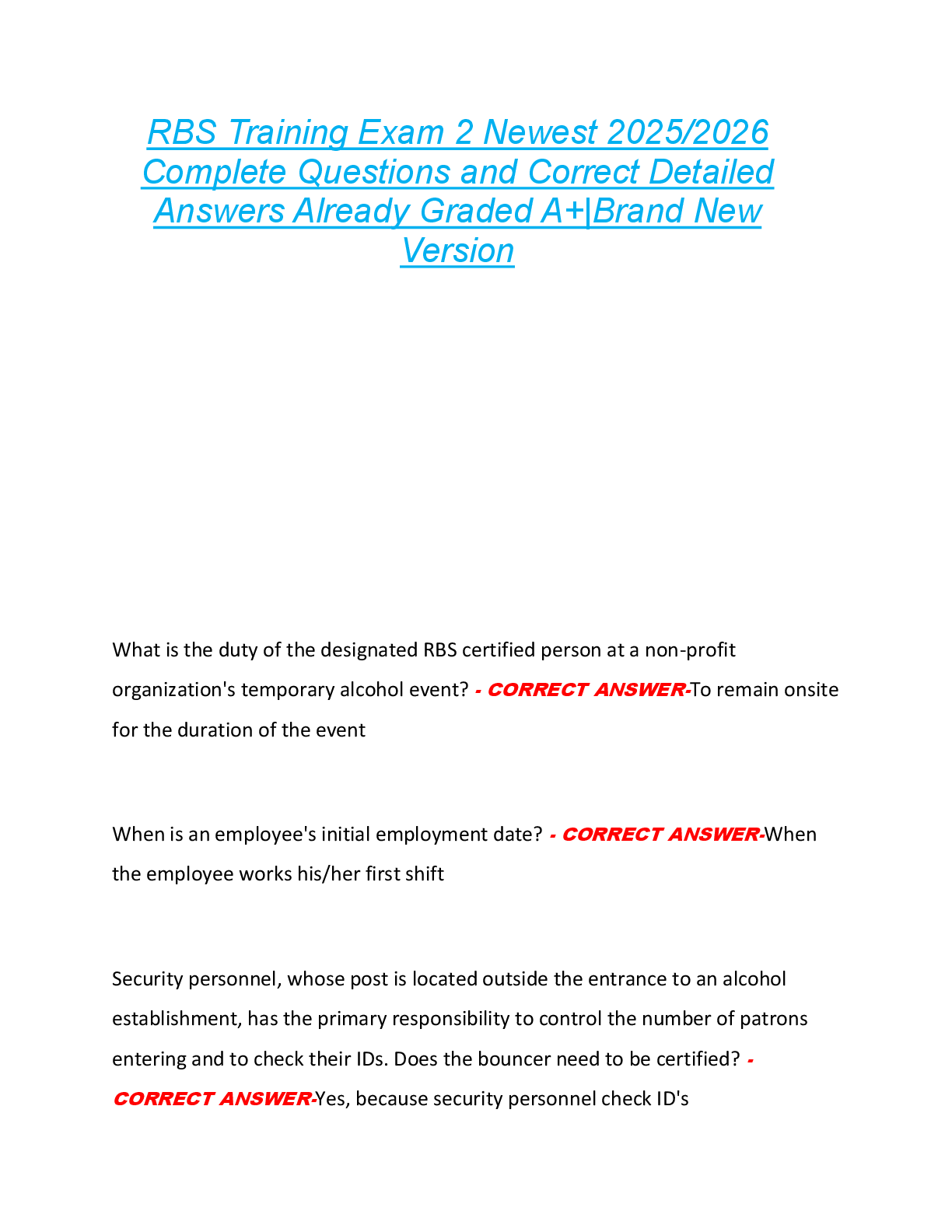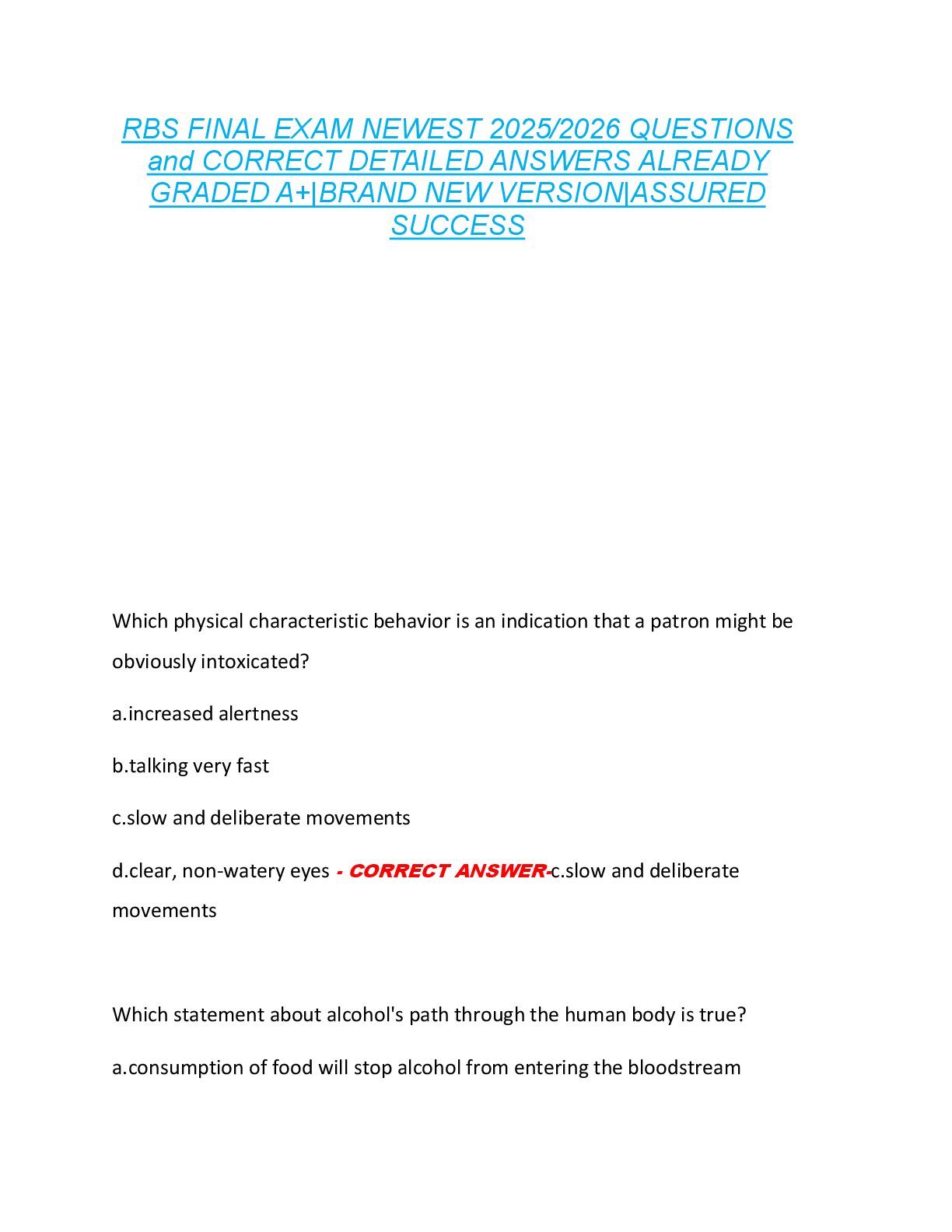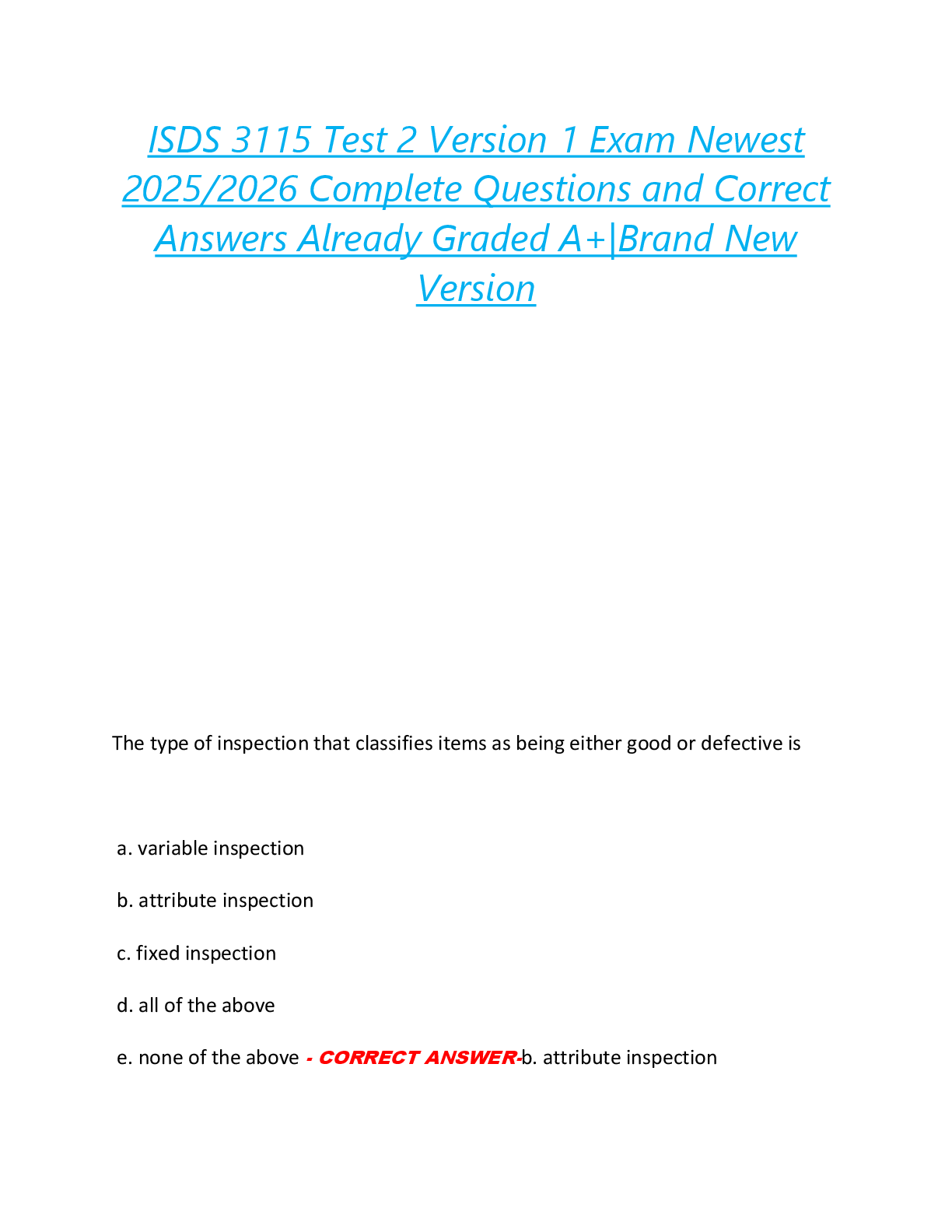Business Research > EXAM > Midterm 2 August 14 Spring 2020, and BUS 1103 Microeconomics - Term 5/questions and answers Microeco (All)
Midterm 2 August 14 Spring 2020, and BUS 1103 Microeconomics - Term 5/questions and answers Microeconomics (University of the People). Contains 100 Pages of the most trested questions and answers
Document Content and Description Below
Midterm 2 August 14 Spring 2020, questions and answers Microeconomics (University of the People) lOMoARcPSD|784381 Question 1 Correct Question text Which of the following resources is scarce i ... n a developed economy? Select one: a. Labor b. Land c. Raw materials d. Tools e. All of these answers Feedback Question 2 Question text The following sentence is a good example of which kind of statement? The next Chairman of the Federal Reserve should be an economist. Select one: a. Normative because it can be verified b. Normative because it expresses an opinion c. Positive because it can be objectively verified d. Positive because it does not express an opinion e. Positive because it cannot be disproven. Feedback lOMoARcPSD|784381 Question 3 Question text The movement along a production possibilities frontier from points (2, 4) to (3, 1) represents which of the following? Select one: a. An opportunity cost of 5 for the first good while maintaining efficient production b. An opportunity cost of 2 for the second good while causing inefficient production c. An opportunity cost of 1 for the first good while causing inefficient production d. An opportunity cost of 2 for the first good while maintaining efficient production e. An opportunity cost of 3 for the second good while maintaining efficient production Feedback Question 4 Question text What does the slope of the production possibilities curve represent? Select one: a. The set of all efficient points of production b. The marginal rate of transformation c. The marginal rate of substitution d. The law of diminishing marginal utility e. The boundary of maximum production Feedback lOMoARcPSD|784381 Question 5 Question text Suppose you make the decision to volunteer for an event in school for an hour this week. This means that you would have to take an hour off from your summer job, for which you earn $10 per hour. You spend $3 in bus fare in order to get to school and $5 for lunch. If you went to work, you would have been able to walk to your job, and lunch would have been provided to you by the office. The opportunity cost of volunteering is: Select one: a. $8 b. $2 c. $18 d. $10 e. $0 Feedback Question 6 Question text Tom owns a bakery and decides to bake a few extra loaves of bread each morning. If he is making a decision "at the margin," it implies that he is comparing: Select one: a. The total revenue to the total cost of producing the bread. b. The total revenue before and after producing the extra loaves. c. The total revenue to the average cost of producing the bread. d. The additional revenue earned to the additional cost of producing the extra loaves of bread. e. The additional customer satisfaction to the additional cost of producing the extra loaves of bread. Feedback lOMoARcPSD|784381 Question 7 Question text Marginal Cost is the: Select one: a. Cost of a small increase in an activity. b. Cost of an activity minus the benefits. c. Cost of a foregone alternative. d. Total cost of an activity. e. Total satisfaction from an activity. Feedback Question 8 Question text Opportunity cost is best defined as: Select one: a. All of the possible alternatives given up. b. The value of the next best alternative that is given up in making a choice. c. The amount of money spent in consuming something. d. The amount of time and money spent in consuming something. e. Total satisfaction from an activity. Feedback lOMoARcPSD|784381 Question 9 Question text Suppose you work forty hours every week and earn $15 per hour. If you wish to work beyond forty hours, your employer agrees to pay you $17 for every extra hour that you work. Your Marginal Benefit from working each extra hour of overtime is: Select one: a. $2 b. $15 c. $17 d. $32 e. The answer cannot be determined from the information given. Feedback Question 10 Question text When making a decision "at the margin," you will consider undertaking more of an activity if the Marginal Benefit from it is __________ the Marginal Cost. Select one: a. Greater than b. Less than c. Less than or at least equal to d. Greater than or at least equal to e. Strictly equal to Feedback lOMoARcPSD|784381 Question 11 Question text The table below shows the Marginal Cost and the Marginal Benefits from producing and consuming sodas (respectively): QuantityMarginal Costs Marginal Benefits 1 6 20 2 8 15 3 10 10 4 12 8 5 14 5 Table 1: Marginal Costs and Benefits In the table above, Economic Efficiency occurs at how many cans of soda? Select one: a. 1 can, because marginal benefit exceeds the marginal cost by as much as possible b. 3 cans, because marginal cost equals marginal benefit at this point c. 1 can, because marginal cost is the least at that point d. 1 can, because marginal benefit is the highest at that point e. The answer cannot be determined from the information given. Feedback Question 12 Question text A point on the production possibilities frontier indicates: Select one: a. That some resources are unemployed. b. That the point is unattainable. c. That the point is inefficient in the production of the two goods. d. That the point is efficient in the production of the two goods. e. The economy is in recession. lOMoARcPSD|784381 Feedback Question 13 Question text Refer to the figure above, which shows the production possibility for a bakery. If the bakery wants to move its production of bread from 4 units to 6, the opportunity cost of increasing bread production is: Select one: a. 2 units of bread b. The loss in muffin production in moving from B to C c. The loss in muffin production in moving from A to B d. The loss in muffin production in moving from A to C e. A paradoxical gain in muffin production. Feedback Question 14 Question text An example of a macroeconomic phenomenon is: Select one: a. The overall welfare (happiness) of a country. b. Income tax rates. c. Gross Domestic Product. d. The unemployment level. e. All of the above. Feedback lOMoARcPSD|784381 Question 15 Question text An example of a microeconomic phenomenon is: Select one: a. The total value of Apple’s stock rises from $500 billion to $600 billion. b. The country of Iceland increases healthcare expenditures by $1 billion. c. The Saudi government builds a new road system for $5 billion. d. India institutes a clean water initiative for $10 billion with the assistance of the World Bank. e. None of the above. Feedback . Question 1 Question text Which of the following causes movement along a product’s demand curve? Select one: a. A marketing campaign b. A change in price of a substitute good c. A change in price of a complimentary good d. A change in the good’s own price e. A change in the number of substitutes Feedback lOMoARcPSD|784381 Question 2 Question text Which of the following will cause the supply of honey to increase? Select one: a. A government tax on honey of 15% of the purchase price b. An increase in the price of honey c. A significant increase in the price of bee keepers’ wages d. An increase in the price of beeswax, a natural derivative of the honey-making process e. A newspaper article warning of possible negative side effects of consuming honey Feedback Question 3 Question text Complete the following sentence. If the quantity demanded exceeds the quantity supplied, then there is: Select one: a. a shortage and the price is below the equilibrium price. b. a shortage and the price is above the equilibrium price. c. a surplus and the price is below the equilibrium price. d. a surplus and the price is above the equilibrium price. e. a surplus and the price is at the equilibrium price. Feedback lOMoARcPSD|784381 Question 4 Question text Suppose the government imposes an excise tax on a product with a demand curve of constant slope of -2. Which of the following will happen? Select one: a. The quantity supplied will fall, and the price will fall, creating a deadweight loss. b. The quantity supplied will fall, and the price will rise, creating a deadweight loss. c. The quantity supplied will fall, and the price will rise, avoiding a deadweight loss. d. The quantity supplied will fall, and the price will fall, avoiding a deadweight loss. e. Quantity supplied and price will remain the same. Feedback Question 5 Question text The term ceteris paribus means: Select one: a. All other things remaining equal. b. The greatest good for the greatest number. c. The study of Scarcity and Choice. d. Incentives. e. Marginal Analysis. Feedback lOMoARcPSD|784381 Question 6 Question text The Law of Demand states that other things remaining the same: Select one: a. As the price of bread increases, the quantity of bread demanded will increase. b. As the price of bread increases, the quantity of bread demanded will decrease. c. As the price of bread falls, the quantity of bread demanded will fall. d. As the demand for bread increases, the price of bread will also increase. e. As the demand for bread increases, the price of bread will stay the same. Feedback Question 7 Question text The Workers Union in a company negotiates a wage increase. How would this affect the supply of the product that the company makes? Select one: a. The Supply curve will shift to the left b. The Supply curve will shift to the right c. It will not affect the Supply curve d. There will be a downward movement along the Supply curve e. There is not enough information to answer. Feedback lOMoARcPSD|784381 Question 8 Question text When the price is below the equilibrium price, which of the following is TRUE? Select one: a. Both the quantity demanded and supplied exceed the equilibrium quantity b. Both the quantity demanded and supplied are less than equilibrium quantity c. The quantity demanded is less than equilibrium quantity, but the quantity supplied is more than equilibrium quantity d. The quantity demanded is more than equilibrium quantity, but the quantity supplied is less than equilibrium quantity e. Both the quantity demanded and supplied equal the equilibrium quantity Feedback Question 9 Question text If the quantity supplied exceeds the quantity demanded, then there is: Select one: a. a shortage and the price is below the equilibrium price b. a shortage and the price is above the equilibrium price c. a surplus and the price is below the equilibrium price d. a surplus and the price is above the equilibrium price e. equilibrium Feedback lOMoARcPSD|784381 Question 10 Question text A Price Floor that is set above the equilibrium price creates a(n) _______. Select one: a. Shortage b. Surplus c. Shift in the Demand curve d. Shift in the Supply curve e. Equilibrium Feedback Question 11 Question text Price Controls create shortages by setting the price __________ the equilibrium price. Select one: a. Above b. Below c. At d. In a different currency than e. None of the above. Feedback lOMoARcPSD|784381 Question 12 Question text Deadweight loss can be described as: Select one: a. The difference between Marginal Benefit and Marginal Loss resulting from the carrying out of an activity b. Excess supply c. Another term for Marginal Loss d. The loss from not consuming an alternate product e. The loss in social surplus resulting from a failure to carry out an activity at the efficient level Feedback Question 13 Question text In the figure above, the region A= $40,000, the region B=$24,000, and the region C=$56,000. Which of the following is the Consumer's Surplus? Select one: a. $64,000 b. $40,000 c. $80,000 d. $120,000 e. $4,000 lOMoARcPSD|784381 Feedback Question 14 Question text In the figure above, the region A= $40,000, the region B=$24,000, and the region C=$56,000. Calculate the Social Surplus. Select one: a. $24,000 b. $40,000 c. $56,000 d. $64,000 e. $120,000 Feedback lOMoARcPSD|784381 Question 15 Question text In the figure above, a price floor “F” has been placed below the equilibrium price “E.” Which algebraic expression correctly calculates the shortage caused at the price floor level? Select one: a. E - Y b. Z - Y c. X - Y d. Z - X e. E - X Feedback lOMoARcPSD|784381 Question 1 Question text Using the mid-point formula, what is the price elasticity of demand for a Starbucks latte whose price increases from $3 a cup to $5 a cup with the resulting change in quantity demanded from 15 cups an hour to 5 cups an hour? Select one: a. 1/3 b. 3 c. 2 d. ½ e. 1 Feedback Question 2 Question text Using the mid-point formula, which describes the price elasticity of demand for a Starbucks latte whose price increases from $3 a cup to $5 a cup with the resulting change in quantity demanded from 15 cups an hour to 5 cups an hour? Select one: a. Inelastic b. Elastic c. Unitary elastic d. Perfectly elastic e. Perfectly inelastic Feedback lOMoARcPSD|784381 Question 3 Question text Given that total revenue = price x quantity, a reduction in price will lead to an increase in total revenue when demand is: Select one: a. Elastic b. Inelastic c. Unit Elastic d. In equilibrium e. Discontinuous Feedback Question 4 Question text A perfectly inelastic supply curve would be ___________. Select one: a. Horizontal b. Downward-sloping c. Upward-sloping d. Vertical e. None of the above Feedback lOMoARcPSD|784381 Question 5 Question text Positive Income Elasticity of a good indicates that the good is __________. Select one: a. A normal good b. An inferior good c. A substitute d. A compliment e. None of the above Feedback Question 6 Question text Negative Cross Price Elasticity of Demand between two goods indicates that the two goods are ________. Select one: a. Substitutes b. Inferior goods c. Compliments d. Normal goods e. None of the above Feedback lOMoARcPSD|784381 Question 7 Question text If demand is more inelastic than supply, then who pays most of the taxes on a good? Select one: a. Suppliers b. Producers c. Consumers d. The government e. The deadweight loss Feedback Question 8 Question text Elasticities are often _____ in the short run than in the long run. Select one: a. lower b. higher c. the same d. unmeasurable e. inflated Feedback lOMoARcPSD|784381 Question 9 Question text An example of a perfectly elastic demand curve would be at: Select one: a. A lawyer’s office b. A supermarket c. A clothing store d. A pharmacy e. A grain auction Feedback Question 10 Question text Complete the following statement. We can expect the cross price elasticity of demand between online and traditional classes to be: Select one: a. positive, indicating substitute goods. b. positive, indicating inferior goods. c. positive, indicating normal goods. d. negative, indicating substitute goods. e. zero, indicating normal goods. Feedback lOMoARcPSD|784381 Question 11 Question text When an increase in income means that one might purchase less of the good, that good is known as: Select one: a. Normal b. Unusual c. Inferior d. Superior e. Unreal Feedback Question 12 Question text A higher level of income for a normal good causes a demand curve to shift to the _____ for a normal good, which means that the income elasticity of demand is ______. Select one: a. right, negative b. left, negative c. left, positive d. right, positive e. left, unitary Feedback lOMoARcPSD|784381 Question 13 Question text The % change in quantity of financial savings divided by % change in interest rate is defined as: Select one: a. Elasticity of labor supply b. Elasticity of savings c. Cross-price elasticity of demand d. Elasticity of interest e. Elasticity of banking Feedback Question 14 Question text Which of the following goods are more likely to have producers shoulder the burden of a tax increase on their good or service? Select one: a. Cable television providers b. Electricity providers c. Cigarette producers d. Insulin producers e. Wine makers Feedback lOMoARcPSD|784381 Question 15 Question text Restaurant meals are generally more elastic than gasoline. Select one: True False Feedback Question 1 Question text The following sentence is a good example of which kind of statement? The current Chairman of the Federal Reserve is an economist. Select one: a. Normative because it can be verified b. Normative because it expresses an opinion c. Positive because it can be objectively verified d. Positive because it does not express an opinion e. Positive because it cannot be disproven Feedback Question 2 Question text Suppose you make the decision to volunteer for an event in school for an hour this week. This means that you would have to take an hour off from your job, for which you earn $15 per hour. You spend $2 in bus fare in order to get to school and $10 for lunch. If you went to work, you would have been able to walk to your job, and lunch would have been provided to you by the office. The opportunity cost of volunteering is: Select one: a. $10 lOMoARcPSD|784381 b. $17 c. $18 d. $27 e. $28 Feedback Question 3 Question text Suppose you work forty hours every week and earn $15 per hour. If you wish to work beyond forty hours, your employer agrees to pay you $20 and gives you a free coffee for every extra hour that you work. Your Marginal Benefit from working each extra hour of overtime is: Select one: a. $5 and a cup of coffee b. $15 c. $ 20 d. $ 20 and a cup of coffee e. The answer cannot be determined from the information given. Feedback Question 4 Question text When making a decision "at the margin," you will NOT consider undertaking more of an activity if the Marginal Benefit from it is __________ the Marginal Cost. Select one: a. Greater than lOMoARcPSD|784381 b. Less than c. Less than or at least equal to d. Greater than or at least equal to e. Strictly equal to Feedback Question 5 Question text The table below shows the Marginal Cost and the Marginal Benefits from producing and consuming cupcakes (respectively): QuantityMarginal Costs Marginal Benefits 1 6 20 2 10 10 3 11 10 4 12 11 5 14 13 Table 1: Marginal Costs and Benefits In the table above, Economic Efficiency occurs at how many cupcakes? Select one: a. 1 cupcake, because marginal benefit exceeds the marginal cost by as much as possible b. 2 cupcakes, because marginal cost equals marginal benefit at this point c. 2 cupcakes, because marginal cost is greater than marginal benefit at this point d. 3 cupcakes because marginal benefit is the highest at that point e. 5 cupcakes because marginal benefit is the highest at that point Feedback lOMoARcPSD|784381 Question 6 Question text Refer to the figure above, which shows the production possibility for a bakery. If the bakery wants to move its production of bread from 6 units to 8, the opportunity cost of increasing bread production is: Select one: a. 2 units of bread b. The loss in muffin production of 2 units c. The loss in muffin production of 5 units d. The loss in muffin production of 10 units e. A paradoxical gain in muffin production Feedback Question 7 Question text 7. Which of the following goods is scarce in a developed economy? Select one: lOMoARcPSD|784381 a. Muffins b. Public Parks c. Light Houses d. Money e. All of these answers Feedback Question 8 Question text In the figure above, the region A= $7, the region B=$8, and the region C=$9. Which of the following is the Consumer's Surplus? Select one: a. $0 b. $7 c. $8 d. $9 e. $15 Feedback lOMoARcPSD|784381 Question 9 Question text In the figure above, a price floor “F” has been placed below the equilibrium price “E.” Which algebraic expression correctly calculates how many fewer units are produced at the price floor level as compared to equilibrium? Select one: a. E - Y b. Z - Y c. X - Y d. Z - X e. E – X Feedback Question 10 Question text The term ceteris paribus means: lOMoARcPSD|784381 Select one: a. All other things remaining equal. b. The greatest good for the greatest number. c. The study of Scarcity and Choice. d. Incentives. e. Marginal analysis. Feedback Question 11 Question text Which of the following causes movement along a banana’s demand curve? Select one: a. A new medical study about the benefits of eating bananas b. A change in price of plantains c. A change in price of a complimentary good, like yogurt d. A change in climate in banana-producing regions e. A change in the price of bananas Feedback Question 12 Question text lOMoARcPSD|784381 In the figure above, the region A= $7, the region B=$8, and the region C=$9. Which of the following is the Social Surplus? Select one: a. $0 b. $7 c. $8 d. $9 e. $15 Feedback Question 13 Question text Suppose the government imposes an excise tax on a product with a demand curve of constant slope of -3. Which of the following will happen? Select one: a. The quantity supplied will fall, and the price will fall, creating a deadweight loss. b. The quantity supplied will fall, and the price will rise, creating a deadweight loss. c. The quantity supplied will fall, and the price will rise, avoiding a deadweight loss. lOMoARcPSD|784381 d. The quantity supplied will fall, and the price will fall, avoiding a deadweight loss. e. Quantity supplied and price will remain the same. Feedback Question 14 Question text A government sets a maximum price for rental units in a city. This regulated price is below the equilibrium price. Which of the following can we expect to happen? Select one: a. The quantity supplied will fall and the quantity demanded demand will fall b. The quantity supplied will fall and the price will rise c. The quantity supplied will fall, and the quantity demanded will rise. d. The quantity supplied will rise avoiding a deadweight loss. e. Quantity supplied and price will remain the same. Feedback Question 15 Question text With an increase in your income, you buy fewer Ramen noodles. That good is known as: Select one: a. Normal b. Unusual c. Inferior d. Superior lOMoARcPSD|784381 e. Unreal Feedback Question 16 Question text An example of a perfectly inelastic demand curve might be at: Select one: a. A lawyer’s office b. A supermarket c. A clothing store d. A hospital emergency room e. A grain auction Feedback Question 17 Question text Using the mid-point formula, what is the price elasticity of demand for a Starbucks latte whose price increases from $2 a cup to $4 a cup with the resulting change in quantity demanded from 25 cups an hour to 15 cups an hour? Select one: a. 1/3 b. 3 c. 3/4 d. ½ e. 1 lOMoARcPSD|784381 Feedback Question 18 Question text Using the mid-point formula, what is the price elasticity of demand for a Starbucks latte whose price increases from $2 a cup to $4 a cup with the resulting change in quantity demanded from 25 cups an hour to 15 cups an hour? Select one: a. Inelastic b. Elastic c. Unitary elastic d. Perfectly elastic e. Perfectly inelastic Feedback Question 19 Question text Negative Income Elasticity of a good indicates that the good is __________. Select one: a. A normal good b. An inferior good c. A substitute d. A compliment e. None of the above Feedback lOMoARcPSD|784381 Question 20 Question text Positive Cross Price Elasticity of Demand between two goods indicates that the two goods are ________. Select one: a. Substitutes b. Inferior goods c. Compliments d. Normal goods e. None of the above Feedback Question 1 Question text Good A Good B Quantity Total Utility Quantity Total Utility 1 20 1 9 2 30 2 29 3 39 3 39 4 46 4 43 5 50 5 44 Which bundle of goods satisfies the equimarginal principle? Select one: a. 5 units of Good A and 5 units of Good B b. 3 units of Good A and 4 units of Good B c. 1 unit of Good A and 1 Unit of Good B lOMoARcPSD|784381 d. 5 units of Good A and 4 units of Good B e. Cannot determine unless budget constraint is specified Question 2 Question text Based on the table below, P1 and P2 indicate the prices of Good 1 and Good 2, respectively. If a consumer consumes a bundle of 3 units of Good A and 3 units of Good B and has no money left over, what is the consumer’s budget constraint? Good A P1 = 1 Good B P2 = 2 Quantity Total Utility Quantity Total Utility 1 20 1 9 2 30 2 29 3 39 3 39 4 46 4 43 5 50 5 44 Select one: a. 0 b. 3 c. 6 d. 9 e. 12 Feedback Question 3 Question text lOMoARcPSD|784381 Given the individual demand functions in the table below, what is the market demand at price P1? Prices A's Demand B's Demand C's Demand D's Demand P1 9 7 1 7 P2 10 10 2 11 P3 11 12 3 14 Select one: a. 32 b. 10 c. 24 d. 26 e. 33 Feedback Question 4 Question text In the Indifference Curve Analysis, a consumer maximizes utility by choosing that combination of goods _______. Select one: a. At which the budget line is tangent to the highest indifference curve b. At which the consumer's marginal rate of substitution is equal to the price ratios of the two goods c. Where the marginal decision rule is satisfied d. All of the above e. None of the above. Feedback lOMoARcPSD|784381 Question 5 Question text Given the Individual Demand Functions in the chart above, the Market Demand at price P2 is: Prices A's Demand B's Demand C's Demand D's Demand P1 5 6 8 4 P2 8 8 10 4 P3 4 5 6 2 Select one: a. 32 b. 10 c. 24 d. 26 e. 30 Feedback Question 6 Question text According to the Equimarginal Principle, utility is maximized when marginal utility per dollar spent is __________. Select one: a. More for one good and less for another b. The same for all goods c. The highest for each good d. Calculated from the budget constraint lOMoARcPSD|784381 e. Zero Feedback Question 7 Question text Based on the table above, P1 and P2 indicate the prices of Good 1 and Good 2, respectively. What is the marginal utility of consuming 3 units of good 1 and 3 units of good 2? Good 1 P1=$2 Good 2 P2=$4 Quantity Total Utility Quantity Total Utility 1 20 1 36 2 30 2 52 3 38 3 64 4 44 4 72 5 48 5 76 Select one: a. 8 of Good 1 and 12 of Good 2 b. 38 of Good 1 and 64 of Good 2 c. 38 of Good 1 and 64 of Good 2 d. 6 of Good 1 and 12 of Good 2 e. Cannot determine unless budget constraint is specified Feedback Question 8 Question text Based on the table above, P1 and P2 indicate the prices of Good 1 and Good 2, respectively. Total utility is maximized when the following combination of Good 1 and Good 2 are purchased: lOMoARcPSD|784381 Good 1 P1=$2 Good 2 P2=$4 Quantity Total Utility Quantity Total Utility 1 20 1 36 2 30 2 52 3 38 3 64 4 44 4 72 5 48 5 76 Select one: a. 5 units of Good 1 and 5 units of Good 2 b. 3 units of Good 1 and 3 units of Good 2 c. 1 unit of Good 1 and 1 unit of Good 2 d. 3 units of Good 1 and 2 units of Good 2 e. Cannot determine unless budget constraint is specified Feedback Question 9 Question text Jane has a weekly budget of $50 to spend on fruit and vegetables. She decides to buy 4 pounds of fruit at a cost of $5/lb. She spends the rest on 5 pounds of vegetables. What is the price she pays for each pound of vegetable, given her budget constraint? Select one: a. $10 b. $6 c. $5 d. $25 lOMoARcPSD|784381 e. $4 Feedback Question 10 Question text If you consume pasta every day of the week, its marginal utility is bound to _________ at the end of the week, ceteris paribus, and this is guided by the law of__________________. Select one: a. Decline, Diminishing Marginal Utility b. Increase, Increasing Marginal Utility c. Increase, Diminishing Marginal Utility d. Decrease, Total Utility e. Stay the same, Equimarginal Principle Feedback Question text The change in consumption of a good that results from the implicit change in income, which has been caused by a price change, is called __________. Select one: a. The substitution effect b. The marginal utility c. Income compensated price change d. Income effect e. Equimarginal Principle lOMoARcPSD|784381 Feedback Question 12 Question text When a price changes, consumers have an incentive to consume less of the good with a relatively higher price and more of the good with a relatively lower price. What explains this? Select one: a. The substitution effect b. The marginal utility c. Income compensated price change d. Income effect e. Equimarginal Principle Feedback Question 13 Question text What does the above graph represent? Select one: lOMoARcPSD|784381 a. A move to a higher indifference curve. b. A move to a lower indifference curve. c. A move to a higher budget constraint. d. A move to a lower budget constraint. e. Unattainable consumption. Feedback Question 14 Question text What does the above graph represent? Select one: a. An increase in the price of Good X. b. An increase in the price of Good Y. c. A decrease in the price of Good X. d. A decrease in the price of Good Y. e. Unattainable consumption. lOMoARcPSD|784381 Feedback Question 15 Question text On the above graph, what does the red point “B” represent? Select one: a. Suboptimal and attainable consumption b. Optimal and attainable consumption c. Optimal but not attainable consumption d. Suboptimal and unattainable consumption e. None of the above Feedback Question 1 Question text Which of the following is always true of the relationship between average and marginal costs? Select one: lOMoARcPSD|784381 a. Average total costs are increasing when marginal costs are increasing. b. Marginal costs are increasing when average variable costs are higher than c. Average variable costs are increasing when marginal costs are increasing. d. Average variable costs are increasing when marginal costs are higher than e. Average total costs are constant when marginal costs are constant. Feedback Question 2 Question text Average total costs are constant when marginal costs are constant. The following table is required to solve this question. Output Total Cost 0 $13 1 $20 2 $25 3 $28 4 $32 5 $43 6 $60 The marginal cost of producing the fourth unit of output is Select one: a. $4 b. $11 lOMoARcPSD|784381 c. $19 d. $32 e. impossible to determine from the information given Feedback Question 3 Question text Average total costs are constant when marginal costs are constant. The following table is required to solve this question. Output Total Cost 0 $13 1 $20 2 $25 3 $28 4 $32 5 $43 6 $60 The total variable cost of producing five units of output is Select one: a. $6 b. $11 c. $30 d. $43 lOMoARcPSD|784381 e. impossible to determine from the information given Feedback Question 4 Question text Average total costs are constant when marginal costs are constant. The following table is required to solve this question. Output Total Cost 0 $13 1 $20 2 $25 3 $28 4 $32 5 $43 6 $60 The profit-maximizing level of output for this firm is Select one: a. 2 b. 3 c. 4 d. 5 e. impossible to determine from the information given Feedback lOMoARcPSD|784381 Question 5 Question text Average total costs are constant when marginal costs are constant. The following table is required to solve this question. Output Total Cost 0 $13 1 $20 2 $25 3 $28 4 $32 5 $43 6 $60 From the table, the fixed cost for this firm is Select one: a. 0 b. 3 c. $20 d. $13 e. impossible to determine Feedback Question 6 Question text As its output increases, a firm’s short-run marginal cost will eventually increase because of lOMoARcPSD|784381 Select one: a. diseconomies of scale b. a lower product price c. inefficient production d. the firm’s need to break even e. diminishing returns Feedback Question 7 Question text For a firm hiring labor in a perfectly competitive labor market, the marginal revenue product curve slopes downward after some point because as more of a factor is employed, which of the following declines? Select one: a. Marginal product b. Marginal factor cost c. Marginal cost d. Total output e. Wage rates Feedback Question 8 Question text If a firm is experiencing diminishing marginal returns to labor, which of the following must be true? Select one: lOMoARcPSD|784381 a. the first workers the firm hired were beter than the workers hired later b. the firm is experiencing decreasing returns to scale c. the positivie effect of specialization in production is being offset by the negative effect of crowding of inputs d. output is decreasing e. the firm should buy more nonlabor inputs Feedback Question 9 Question text The marginal product of labor is the Select one: a. cost of one worker b. average output per worker c. change in revenue from selling one more unit of output d. change in revenue from using one more unit of labor e. change in output from using one more unit of labor Feedback Question 10 Question text Which of the following is a fixed cost for Wendy's Hamburgers? Select one: a. the cost of beef b. electricity to light up the Wendy's sign lOMoARcPSD|784381 c. gasoline for the trucks that deliver supplies to the various franchises d. interest on funds borrowed to build new facilities e. expenditures on paper and plastic for packaging Feedback Question 11 Question text If fixed cost at Q = 100 is $130, then Select one: a. fixed cost at Q = 0 is $0 b. fixed cost at Q = 0 is less than $130 c. fixed cost at Q = 200 is $260 d. fixed cost at Q = 200 is $130 e. it is impossible to calculate fixed costs at any other quantity Feedback Question 12 Question text What is true of marginal cost when marginal returns are decreasing Select one: a. it is negative and increasing b. it is negative and decreasing c. it is positive and increasing d. it is positive and decreasing e. it is positive and has a constant slope lOMoARcPSD|784381 Feedback Question 13 Question text Suppose Guild produces 5,000 guitars per year. Its average total cost is $90, and its fixed cost is $250,000. What is its variable cost? Select one: a. 250,000 b. 450,000 c. 25,000 d. 56,000 e. 200,000 Feedback Question 14 Question text If your overall grade point average is 2.0 and you earn a 2.5 GPA this semester, your overall grade point average will increase. This situation demonstrates the general principle that Select one: a. if average value is greater than marginal value, marginal value will b. if average value is greater than total value, total value will increase c. if marginal value is greater than average value, average value will d. if marginal value is greater than total value, total value will increase e. if the second total is greater than the first total, the average is Feedback lOMoARcPSD|784381 Question 15 Question text For building contractors, doubling the size of an office building does not require double the inputs because there are common walls. This is an example of Select one: a. increasing marginal product b. diminishing marginal returns c. economies of scale d. diseconomies of scale e. constant returns to scale Feedback Question 16 Question text All the decisions make for a firm have one overriding objective, which is to _________________. Select one: a. maximize the quantity that it sells b. maximize its total revenue c. maximize its market share d. make maximum attainable profit Feedback 1 Question text Which of the following is not a valid option for a perfectly competitive firm? lOMoARcPSD|784381 Select one: a. Increasing its output b. Decreasing its output c. Increasing its price d. Increasing its resources Question 2 Question text In the long run, a perfectly competitive firm will achieve all but which of the following: Select one: a. Economic profit b. Allocative Efficiency c. Productive Efficiency d. Normal profit Question 3 Question text If the price a firm receives for its product is equal to the marginal cost of producing that product, the firm is: Select one: a. Always earning an economic profit b. Always productively efficient c. Always allocatively efficient d. Always experiencing an economic loss Question 4 Question text lOMoARcPSD|784381 A firm that is producing at the lowest possible average cost is always: Select one: a. Earning an economic profit. b. Productively efficient c. Dominating the other firms in the market d. Not producing enough output Question 5 Question text A perfectly competitive firm should always: Select one: a. Earn an economic profit b. Increase its price if it is experiencing an economic loss c. Produce the quantity where its marginal cost equals its marginal revenue d. Produce at the productively efficient level of output Question 6 Question text The supply curve for a perfect competitor is its: Select one: a. Marginal Revenue Curve b. ATC curve c. MC curve d. MC curve above its AVC curve Question 7 Question text lOMoARcPSD|784381 If a perfect competitor is producing at a level where its average cost is $8, and its marginal cost is $9, and it is receiving a price of $10 for its product, the firm Select one: a. Is maximizing economic profit b. Experiencing economic loss c. Should increase its output d. Is allocatively efficient Question 8 Question text If a profit maximizing perfectly competitive firm is selling 1000 units at a price of $10 and its average total cost is $8 the firm is experiencing: Select one: a. A total profit of $2 b. A total profit of $2000 c. A price greater than its marginal cost d. An economic loss Question 9 Question text Which of the following is most likely to happen if a typical firm in a perfectly competitive market is experiencing an average revenue that is greater than its average cost? Select one: a. Price will increase b. Other firms will enter the market c. Other firms will leave the market d. Demand will decrease lOMoARcPSD|784381 Question 10 Question text If the typical firm in a perfectly competitive market is experiencing an economic loss, which of the following will happen? Select one: a. Firms will enter the market and the price will decrease b. Firms will enter the market and the price will increase c. Firms will exit the market and the price will decrease d. Firms will exit the market and the price will increase Question 11 Question text A perfectly competitive firm that is in long-run equilibrium will Select one: a. Earn an economic profit, be allocatively efficient, and be productively efficient. b. Not earn an economic profit, but be allocatively efficient and productively efficient c. Not earn an economic profit, not be allocatively efficient, but be productively efficient. d. Not earn an economic profit, not be productively efficient, but be allocatively efficient Question 12 Question text A firm in a perfectly competitive industry has Select one: a. A perfectly elastic supply curve b. A perfectly elastic demand curve c. A negatively sloped demand curve d. A positively sloped demand curve lOMoARcPSD|784381 Question 13 Question text A perfectly competitive industry has Select one: a. perfectly elastic supply curve b. perfectly elastic demand curve c. negatively sloped demand curve d. positively sloped demand curve Question 14 Question text A perfectly competitive firm that is receiving a price of $5 and has a marginal cost of $6 should always Select one: a. drop out of the industry b. decrease its output c. increase its price d. increase its output Question 15 Question text Assume that a perfectly competive firm that produces widgets is in long-run equilibrium. Then suddenly the market demand for widgets increases. The firm will Select one: a. experience an economic loss b. Experience an economic profit and produce more in the short run. c. Experience an economic profit and produce less in the short run d. Experience no economic profit in the short run lOMoARcPSD|784381 lOMoARcPSD|784381 16/08/2018 Final Exam https://my.uopeople.edu/mod/quiz/attempt.php?attempt=1355192 1/6 Home ► My courses ► BUS 1103 - AY2018-T5 ► Final Exam (Days 1 - 4) ► Final Exam Question 1 Answer saved Marked out of 1.00 Question 2 Answer saved Marked out of 1.00 Complete the following sentence. When the long run average cost (LRAC) curve has a positive slope, it implies there are: Select one: a. increasing returns to scale. b. constant returns to scale. c. decreasing returns to scale. d. diseconomies of scale. e. none of the above Which Gini coeÕcient indicates the least equitable distribution of income? Select one: a. 0 b. 0.45 c. 1.0 d. 2.0 e. None of the above BUS 1103 Microeconomics - Term 5, 2017-2018 lOMoARcPSD|784381 16/08/2018 Final Exam https://my.uopeople.edu/mod/quiz/attempt.php?attempt=1355192 2/6 Question 3 Answer saved Marked out of 1.00 In the above graph, there is a production possibility frontier for two countries, Y and Z. Which Point is both eÕcient and attainable for country Y? Select one: a. A b. B c. C d. D e. E lOMoARcPSD|784381 16/08/2018 Final Exam https://my.uopeople.edu/mod/quiz/attempt.php?attempt=1355192 3/6 Question 4 Answer saved Marked out of 1.00 Question 5 Answer saved Marked out of 1.00 Question 6 Answer saved Marked out of 1.00 In monopolistic competition: Select one: a. Firms face a perfectly inelastic demand curve b. There is one supplier c. Firms make di×erentiated products d. There are barriers to entry to prevent entry e. There is never government regulation The substitution e×ect happens when a price changes, consumers have an incentive to consume less of the good with a relatively higher price and more of the good with a relatively lower price. Select one: True False Negative Cross Price Elasticity of Demand between two goods indicates that the two goods are ________. Select one: a. Substitutes b. Inferior goods c. Compliments d. Normal goods e. None of the above lOMoARcPSD|784381 16/08/2018 Final Exam https://my.uopeople.edu/mod/quiz/attempt.php?attempt=1355192 4/6 Question 7 Answer saved Marked out of 1.00 The graph above depicts a demand curve for a Òrm. In which market structure is the Òrm operating? Select one: a. Monopoly b. Oligopoly c. Monopolistic competition d. Perfect competition e. Deadweight loss lOMoARcPSD|784381 16/08/2018 Final Exam https://my.uopeople.edu/mod/quiz/attempt.php?attempt=1355192 5/6 Question 8 Answer saved Marked out of 1.00 Question 9 Answer saved Marked out of 1.00 Prices A's Demand B's Demand C's Demand D's Demand P1 5 6 4 4 P2 8 8 4 4 P3 4 5 4 2 Given the Individual Demand Functions in the chart above, the Market Demand at price P1 is: Select one: a. 10 b. 19 c. 20 d. 26 e. 30 According to the World Bank, which is a problem associated with excessive income inequality? Select one: a. Reduction in the pool of people with access to resources b. Political instability c. Lower social trust and commitment d. Limited economic tools to manage large sections of the population’s needs e. All of the above lOMoARcPSD|784381 16/08/2018 Final Exam https://my.uopeople.edu/mod/quiz/attempt.php?attempt=1355192 6/6 Question 10 Answer saved Marked out of 1.00 Which most closely approximates a perfectly competitive market? Select one: a. An electric utility b. An Ethiopian-style restaurant c. The airline industry d. A farmers’ market e. The beverage market lOMoARcPSD|784381 16/08/2018 Final Exam https://my.uopeople.edu/mod/quiz/attempt.php?attempt=1355192&page=1 1/8 Home ► My courses ► BUS 1103 - AY2018-T5 ► Final Exam (Days 1 - 4) ► Final Exam Question 11 Answer saved Marked out of 1.00 Question 12 Answer saved Marked out of 1.00 The production possibilities frontier shows the possible combinations of two goods that are a×ordable given a consumer’s limited income. Select one: True False Suppose you make the decision to volunteer for an event in school for an hour this week. This means that you would have to take an hour o× from your summer job, for which you earn $18 per hour. You spend $2 in bus fare in order to to school and $7 for lunch. However, you won a $10 gift card for being best volunteer of the day! If you went to work, you would have been able to walk to your job, and lunch would have been provided to you by the oÕce, but you won’t have received the gift card. The opportunity cost of volunteering is: Select one: a. $8 b. $2 c. $17 d. $10 e. The answer cannot be determined because the gift card cannot be valued. BUS 1103 Microeconomics - Term 5, 2017-2018 come lOMoARcPSD|784381 16/08/2018 Final Exam https://my.uopeople.edu/mod/quiz/attempt.php?attempt=1355192&page=1 2/8 Question 13 Answer saved Marked out of 1.00 On the above graph, what does the blue point “A” represent? Select one: a. Suboptimal and attainable consumption b. Optimal and attainable consumption c. Optimal but not attainable consumption d. Unattainable consumption e. A bliss point lOMoARcPSD|784381 16/08/2018 Final Exam https://my.uopeople.edu/mod/quiz/attempt.php?attempt=1355192&page=1 3/8 Question 14 Answer saved Marked out of 1.00 In this Lorenz Curve, the formula for the GINI coeÕcient is: (Yellow Area) / (Yellow Area + Green Area). If the Yellow Area is 0.1 and the Green Area is 0.4, what is the GINI coeÕcient? Select one: a. 0.1 b. 0.2 c. 0.4 d. 0.5 e. 1.0 lOMoARcPSD|784381 16/08/2018 Final Exam https://my.uopeople.edu/mod/quiz/attempt.php?attempt=1355192&page=1 4/8 Question 15 Answer saved Marked out of 1.00 Quantity of hats produced Total Cost 0 15 1 40 2 60 3 70 4 75 5 78 Given this total cost schedule, what is the Òrm’s Òxed cost? Select one: a. 15 b. 10 c. 25 d. 78 e. 0 lOMoARcPSD|784381 16/08/2018 Final Exam https://my.uopeople.edu/mod/quiz/attempt.php?attempt=1355192&page=1 5/8 Question 16 Answer saved Marked out of 1.00 In the Ògure above, a price control “F” has been placed above the equilibrium price “E.” Which algebraic expression correctly calculates the surplus caused at the price control level? Select one: a. E - A b. B + A c. E - B d. A – B + E e. B - A lOMoARcPSD|784381 16/08/2018 Final Exam https://my.uopeople.edu/mod/quiz/attempt.php?attempt=1355192&page=1 6/8 Question 17 Answer saved Marked out of 1.00 If the purple line is the Lorenz Curve for a country, what does it represent? Select one: a. Perfect income equality b. A communist system c. A capitalist system d. Swedish socialism e. Perfect income inequality lOMoARcPSD|784381 16/08/2018 Final Exam https://my.uopeople.edu/mod/quiz/attempt.php?attempt=1355192&page=1 7/8 Question 18 Answer saved Marked out of 1.00 Refer to the Ògure above, which shows the production possibility for a bakery. If the bakery wants to move its production of bread from 8 units to 6, the opportunity cost of increasing bread production is: Select one: a. 2 units of bread b. The gain in muÕn production of 2 units c. The gain in muÕn production of 5 units d. The loss in muÕn production of 10 units e. A paradoxical loss in muÕn production lOMoARcPSD|784381 16/08/2018 Final Exam https://my.uopeople.edu/mod/quiz/attempt.php?attempt=1355192&page=1 8/8 Question 19 Answer saved Marked out of 1.00 Question 20 Answer saved Marked out of 1.00 The following sentence is a good example of which kind of statement? “A CEO should be a strong leader.” Select one: a. Normative because it can be veriÒed b. Normative because it expresses an opinion c. Positive because it can be objectively veriÒed d. Positive because it does not express an opinion e. Positive because it cannot be disproven. If demand is more elastic than supply, then who pays most of the taxes on a good? Select one: a. Foreign governments b. Producers c. Consumers d. The government e. The deadweight loss. lOMoARcPSD|784381 16/08/2018 Final Exam https://my.uopeople.edu/mod/quiz/attempt.php?attempt=1355192&page=3 1/6 Home ► My courses ► BUS 1103 - AY2018-T5 ► Final Exam (Days 1 - 4) ► Final Exam Question 31 Answer saved Marked out of 1.00 Question 32 Answer saved Marked out of 1.00 Question 33 Answer saved Marked out of 1.00 In a perfectly competitive market, the price equals __________. Select one: a. Marginal revenue divided by output b. Average revenue c. Total revenue divided by marginal revenue d. All of the above e. None of the above Economics can be deÒned as the study of scarcity. Select one: True False The change in consumption of a good that results from the implicit change in income, which has been caused by a price change, is called __________. Select one: a. The substitution e×ect b. The marginal utility c. Income compensated price change d. Income e×ect e. Equimarginal Principle BUS 1103 Microeconomics - Term 5, 2017-2018 lOMoARcPSD|784381 16/08/2018 Final Exam https://my.uopeople.edu/mod/quiz/attempt.php?attempt=1355192&page=3 2/6 Question 34 Answer saved Marked out of 1.00 Question 35 Answer saved Marked out of 1.00 An example of a microeconomic phenomenon is: Select one: a. Global warming research turns out to correctly predict the weather in the future. b. The dictator of a country builds ten new airports. c. A child buys a delicious chocolate bar. d. The country of Montenegro adopts the Euro. e. None of the above. Fixed costs do not change with the level of output. Select one: True False lOMoARcPSD|784381 16/08/2018 Final Exam https://my.uopeople.edu/mod/quiz/attempt.php?attempt=1355192&page=3 3/6 Question 36 Answer saved Marked out of 1.00 Based on the table below, P1 and P2 indicate the prices of Good 1 and Good 2, respectively. If a consumer consumes a bundle of 3 units of Good A and 3 units of Good B and has no money left over, what is the consumer’s budget constraint? Good A P1 = 2 Good B P2 = 2 Quantity Total Utility Quantity Total Utility 1 20 1 9 2 30 2 29 3 39 3 39 4 46 4 43 5 50 5 44 Select one: a. 0 b. 3 c. 6 d. 9 e. 12 lOMoARcPSD|784381 16/08/2018 Final Exam https://my.uopeople.edu/mod/quiz/attempt.php?attempt=1355192&page=3 4/6 Question 37 Answer saved Marked out of 1.00 Given the above graph, which of the following are true? Select one: a. The consumer operating at line N can consume twice as much of Good Y than Good X. b. The consumer operating at line M can consume twice as much of Good Y than Good X. c. The consumer operating at line M will always consume less of both goods. d. Choices A and B. e. Choices B and C. lOMoARcPSD|784381 16/08/2018 Final Exam https://my.uopeople.edu/mod/quiz/attempt.php?attempt=1355192&page=3 5/6 Question 38 Answer saved Marked out of 1.00 Question 39 Answer saved Marked out of 1.00 Good A Good B Quantity Total Utility Quantity Total Utility 1 20 1 21 2 35 2 35 3 45 3 44 4 48 4 47 5 50 5 48 Which bundle of goods satisÒes the equimarginal principle? Select one: a. 5 units of Good A and 5 units of Good B b. 4 units of Good A and 3 units of Good B c. 1 unit of Good A and 1 Unit of Good B d. 5 units of Good A and 4 units of Good B e. 4 units of Good A and 4 units of Good B Positive Income Elasticity of a good indicates that the good is __________. Select one: a. A normal good b. An inferior good c. A substitute d. A compliment e. None of the above lOMoARcPSD|784381 16/08/2018 Final Exam https://my.uopeople.edu/mod/quiz/attempt.php?attempt=1355192&page=3 6/6 Question 40 Answer saved Marked out of 1.00 After a revolution in a country with exceptionally high income inequality, a government institutes an extreme income transfer program from wealthy families to impoverished ones. How is this represented in the Lorenz curve? Select one: a. Movement from D to C. b. Movement from C to A. c. Movement from C to B. d. Movement from B to D. e. Movement from B to C. lOMoARcPSD|784381 Home → My courses → BUS 1103 - AY2018-T5 → 26 July - 1 August → Graded Quiz Unit 6 Question 1 Correct Mark 1.00 out of 1.00 Started on Tuesday, 31 July 2018, 5:10 PM State Finished Completed on Tuesday, 31 July 2018, 5:23 PM Time taken 13 mins 5 secs Marks 20.00/20.00 Grade 100.00 out of 100.00 Given the individual demand functions in the table below, what is the market demand at price P1? Prices A's Demand B's Demand C's Demand D's Demand P1 9 7 1 7 P2 10 10 2 11 P3 11 12 3 14 Select one: a. 32 b. 10 c. 24 d. 26 e. 33 The correct answer is: 24 BUS 1103 Microeconomics - Term 5, 2017-2018 lOMoARcPSD|784381 Question 2 Correct Mark 1.00 out of 1.00 Good A Good B Quantity Total Utility Quantity Total Utility 1 20 1 9 2 30 2 29 3 39 3 39 4 46 4 43 5 50 5 44 Which bundle of goods satis�es the equimarginal principle? Select one: a. 5 units of Good A and 5 units of Good B b. 3 units of Good A and 4 units of Good B c. 1 unit of Good A and 1 Unit of Good B d. 5 units of Good A and 4 units of Good B e. Cannot determine unless budget constraint is speci�ed The correct answer is: Cannot determine unless budget constraint is speci�ed lOMoARcPSD|784381 Question 3 Correct Mark 1.00 out of 1.00 Question 4 Correct Mark 1.00 out of 1.00 If a pro�t maximizing perfectly competitive �rm is selling 1000 units at a price of $10 and its average total cost is $8 the �rm is experiencing: Select one: a. A total pro�t of $2 b. A total pro�t of $2000 c. A price greater than its marginal cost d. An economic loss The correct answer is: A total pro�t of $2000 In the long run, a perfectly competitive �rm will achieve all but which of the following: Select one: a. Economic pro�t b. Allocative E�ciency c. Productive E�ciency d. Normal pro�t The correct answer is: Normal pro�t lOMoARcPSD|784381 Question 5 Correct Mark 1.00 out of 1.00 Question 6 Correct Mark 1.00 out of 1.00 A perfectly competitive �rm that is in long-run equilibrium will Select one: a. Earn an economic pro�t, be allocatively e�cient, and be productively e�cient. b. Not earn an economic pro�t, but be allocatively e�cient and productively e�cient c. Not earn an economic pro�t, not be allocatively e�cient, but be productively e�cient. d. Not earn an economic pro�t, not be productively e�cient, but be allocatively e�cient The correct answer is: Not earn an economic pro�t, but be allocatively e�cient and productively e�cient When a price changes, consumers have an incentive to consume less of the good with a relatively higher price and more of the good with a relatively lower price. What explains this? Select one: a. The substitution e�ect b. The marginal utility c. Income compensated price change d. Income e�ect e. Equimarginal Principle The correct answer is: The substitution e�ect lOMoARcPSD|784381 Question 7 Correct Mark 1.00 out of 1.00 Question 8 Correct Mark 1.00 out of 1.00 Given the Individual Demand Functions in the chart above, the Market Demand at price P2 is: Prices A's Demand B's Demand C's Demand D's Demand P1 5 6 8 4 P2 8 8 10 4 P3 4 5 6 2 Select one: a. 32 b. 10 c. 24 d. 26 e. 30 The correct answer is: 30 A �rm that is producing at the lowest possible average cost is always: Select one: a. Earning an economic pro�t. b. Productively e�cient c. Dominating the other �rms in the market d. Not producing enough output The correct answer is: Productively e�cient lOMoARcPSD|784381 Question 9 Correct Mark 1.00 out of 1.00 Based on the table below, P1 and P2 indicate the prices of Good 1 and Good 2, respectively. If a consumer consumes a bundle of 3 units of Good A and 3 units of Good B and has no money left over, what is the consumer’s budget constraint? Good A P1 = 1 Good B P2 = 2 Quantity Total Utility Quantity Total Utility 1 20 1 9 2 30 2 29 3 39 3 39 4 46 4 43 5 50 5 44 Select one: a. 0 b. 3 c. 6 d. 9 e. 12 The correct answer is: 9 lOMoARcPSD|784381 Question 10 Correct Mark 1.00 out of 1.00 Question 11 Correct Mark 1.00 out of 1.00 Assume that a perfectly competive �rm that produces widgets is in long-run equilibrium. Then suddenly the market demand for widgets increases. The �rm will Select one: a. experience an economic loss b. Experience an economic pro�t and produce more in the short run. c. Experience an economic pro�t and produce less in the short run d. Experience no economic pro�t in the short run The correct answer is: Experience an economic pro�t and produce more in the short run. If the price a �rm receives for its product is equal to the marginal cost of producing that product, the �rm is: Select one: a. Always earning an economic pro�t b. Always productively e�cient c. Always allocatively e�cient d. Always experiencing an economic loss The correct answer is: Always allocatively e�cient lOMoARcPSD|784381 Question 12 Correct Mark 1.00 out of 1.00 Question 13 Correct Mark 1.00 out of 1.00 The supply curve for a perfect competitor is its: Select one: a. Marginal Revenue Curve b. ATC curve c. MC curve d. MC curve above its AVC curve The correct answer is: MC curve Which of the following is most likely to happen if a typical �rm in a perfectly competitive market is experiencing an average revenue that is greater than its average cost? Select one: a. Price will increase b. Other �rms will enter the market c. Other �rms will leave the market d. Demand will decrease The correct answer is: Other �rms will enter the market lOMoARcPSD|784381 Question 14 Correct Mark 1.00 out of 1.00 What does the above graph represent? Select one: a. An increase in the price of Good X. b. An increase in the price of Good Y. c. A decrease in the price of Good X. d. A decrease in the price of Good Y. e. Unattainable consumption. The correct answer is: A decrease in the price of Good X. lOMoARcPSD|784381 Question 15 Correct Mark 1.00 out of 1.00 Question 16 Correct Mark 1.00 out of 1.00 If the typical �rm in a perfectly competitive market is experiencing an economic loss, which of the following will happen? Select one: a. Firms will enter the market and the price will decrease b. Firms will enter the market and the price will increase c. Firms will exit the market and the price will decrease d. Firms will exit the market and the price will increase The correct answer is: Firms will exit the market and the price will increase A �rm in a perfectly competitive industry has Select one: a. A perfectly elastic supply curve b. A perfectly elastic demand curve c. A negatively sloped demand curve d. A positively sloped demand curve The correct answer is: A perfectly elastic demand curve lOMoARcPSD|784381 Question 17 Correct Mark 1.00 out of 1.00 Question 18 Correct Mark 1.00 out of 1.00 A perfectly competitive �rm should always: Select one: a. Earn an economic pro�t b. Increase its price if it is experiencing an economic loss c. Produce the quantity where its marginal cost equals its marginal revenue d. Produce at the productively e�cient level of output The correct answer is: Produce the quantity where its marginal cost equals its marginal revenue If a perfect competitor is producing at a level where its average cost is $8, and its marginal cost is $9, and it is receiving a price of $10 for its product, the �rm Select one: a. Is maximizing economic pro�t b. Experiencing economic loss c. Should increase its output d. Is allocatively e�cient The correct answer is: Should increase its output lOMoARcPSD|784381 Question 19 Correct Mark 1.00 out of 1.00 Question 20 Correct Mark 1.00 out of 1.00 The change in consumption of a good that results from the implicit change in income, which has been caused by a price change, is called __________. Select one: a. The substitution e�ect b. The marginal utility c. Income compensated price change d. Income e�ect e. Equimarginal Principle The correct answer is: Income e�ect A perfectly competitive �rm that is receiving a price of $5 and has a marginal cost of $6 should always Select one: a. drop out of the industry b. decrease its output c. increase its price d. increase its output The correct answer is: decrease its output lOMoARcPSD|784381 30/07/2018 Graded Quiz Unit 6 https://my.uopeople.edu/mod/quiz/attempt.php 1/9 Home ► My courses ► BUS 1103 - AY2018-T5 ► 26 July - 1 August ► Graded Quiz Unit 6 Question 1 Answer saved Marked out of 1.00 Question 2 Answer saved Marked out of 1.00 If the price a Òrm receives for its product is equal to the marginal cost of producing that product, the Òrm is: Select one: a. Always earning an economic proÒt b. Always productively eÕcient c. Always allocatively eÕcient d. Always experiencing an economic loss If you consume pasta every day of the week, its marginal utility is bound to _________ at the end of the week, ceteris paribus, and this is guided by the law of__________________. Select one: a. Decline, Diminishing Marginal Utility b. Increase, Increasing Marginal Utility c. Increase, Diminishing Marginal Utility d. Decrease, Total Utility e. Stay the same, Equimarginal Principle BUS 1103 Microeconomics - Term 5, 2017-2018 lOMoARcPSD|784381 30/07/2018 Graded Quiz Unit 6 https://my.uopeople.edu/mod/quiz/attempt.php 2/9 Question 3 Answer saved Marked out of 1.00 Question 4 Answer saved Marked out of 1.00 What does the above graph represent? Select one: a. An increase in the price of Good X. b. An increase in the price of Good Y. c. A decrease in the price of Good X. d. A decrease in the price of Good Y. e. Unattainable consumption. If the typical Òrm in a perfectly competitive market is experiencing an economic loss, which of the following will happen? Select one: a. Firms will enter the market and the price will decrease b. Firms will enter the market and the price will increase c. Firms will exit the market and the price will decrease d. Firms will exit the market and the price will increase lOMoARcPSD|784381 30/07/2018 Graded Quiz Unit 6 https://my.uopeople.edu/mod/quiz/attempt.php 3/9 Question 5 Answer saved Marked out of 1.00 Question 6 Answer saved Marked out of 1.00 Question 7 Answer saved Marked out of 1.00 A Òrm that is producing at the lowest possible average cost is always: Select one: a. Earning an economic proÒt. b. Productively eÕcient c. Dominating the other Òrms in the market d. Not producing enough output A perfectly competitive industry has Select one: a. perfectly elastic supply curve b. perfectly elastic demand curve c. negatively sloped demand curve d. positively sloped demand curve Jane has a weekly budget of $50 to spend on fruit and vegetables. She decides to buy 4 pounds of fruit at a cost of $5/lb. She spends the rest on 5 pounds of vegetables. What is the price she pays for each pound of vegetable, given her budget constraint? Select one: a. $10 b. $6 c. $5 d. $25 e. $4 lOMoARcPSD|784381 30/07/2018 Graded Quiz Unit 6 https://my.uopeople.edu/mod/quiz/attempt.php 4/9 Question 8 Answer saved Marked out of 1.00 Question 9 Answer saved Marked out of 1.00 Given the individual demand functions in the table below, what is the market demand at price P1? Prices A's Demand B's Demand C's Demand D's Demand P1 9 7 1 7 P2 10 10 2 11 P3 11 12 3 14 Select one: a. 32 b. 10 c. 24 d. 26 e. 33 Which of the following is most likely to happen if a typical Òrm in a perfectly competitive market is experiencing an average revenue that is greater than its average cost? Select one: a. Price will increase b. Other Òrms will enter the market c. Other Òrms will leave the market d. Demand will decrease lOMoARcPSD|784381 30/07/2018 Graded Quiz Unit 6 https://my.uopeople.edu/mod/quiz/attempt.php 5/9 Question 10 Answer saved Marked out of 1.00 Question 11 Answer saved Marked out of 1.00 On the above graph, what does the red point “B” represent? Select one: a. Suboptimal and attainable consumption b. Optimal and attainable consumption c. Optimal but not attainable consumption d. Suboptimal and unattainable consumption e. None of the above Assume that a perfectly competive Òrm that produces widgets is in longrun equilibrium. Then suddenly the market demand for widgets increases. The Òrm will Select one: a. experience an economic loss b. Experience an economic proÒt and produce more in the short run. c. Experience an economic proÒt and produce less in the short run d. Experience no economic proÒt in the short run lOMoARcPSD|784381 30/07/2018 Graded Quiz Unit 6 https://my.uopeople.edu/mod/quiz/attempt.php 6/9 Question 12 Answer saved Marked out of 1.00 Question 13 Answer saved Marked out of 1.00 A Òrm in a perfectly competitive industry has Select one: a. A perfectly elastic supply curve b. A perfectly elastic demand curve c. A negatively sloped demand curve d. A positively sloped demand curve Based on the table below, P1 and P2 indicate the prices of Good 1 and Good 2, respectively. If a consumer consumes a bundle of 3 units of Good A and 3 units of Good B and has no money left over, what is the consumer’s budget constraint? Good A P1 = 1 Good B P2 = 2 Quantity Total Utility Quantity Total Utility 1 20 1 9 2 30 2 29 3 39 3 39 4 46 4 43 5 50 5 44 Select one: a. 0 b. 3 c. 6 d. 9 e. 12 lOMoARcPSD|784381 30/07/2018 Graded Quiz Unit 6 https://my.uopeople.edu/mod/quiz/attempt.php 7/9 Question 14 Answer saved Marked out of 1.00 Question 15 Answer saved Marked out of 1.00 Question 16 Answer saved Marked out of 1.00 The supply curve for a perfect competitor is its: Select one: a. Marginal Revenue Curve b. ATC curve c. MC curve d. MC curve above its AVC curve A perfectly competitive Òrm that is receiving a price of $5 and has a marginal cost of $6 should always Select one: a. drop out of the industry b. decrease its output c. increase its price d. increase its output If a perfect competitor is producing at a level where its average cost is $8, and its marginal cost is $9, and it is receiving a price of $10 for its product, the Òrm Select one: a. Is maximizing economic proÒt b. Experiencing economic loss c. Should increase its output d. Is allocatively eÕcient lOMoARcPSD|784381 30/07/2018 Graded Quiz Unit 6 https://my.uopeople.edu/mod/quiz/attempt.php 8/9 Question 17 Answer saved Marked out of 1.00 Question 18 Answer saved Marked out of 1.00 Question 19 Answer saved Marked out of 1.00 A perfectly competitive Òrm that is in long-run equilibrium will Select one: a. Earn an economic proÒt, be allocatively eÕcient, and be productively eÕcient. b. Not earn an economic proÒt, but be allocatively eÕcient and productively eÕcient c. Not earn an economic proÒt, not be allocatively eÕcient, but be productively eÕcient. d. Not earn an economic proÒt, not be productively eÕcient, but be allocatively eÕcient The change in consumption of a good that results from the implicit change in income, which has been caused by a price change, is called __________. Select one: a. The substitution e×ect b. The marginal utility c. Income compensated price change d. Income e×ect e. Equimarginal Principle In the long run, a perfectly competitive Òrm will achieve all but which of the following: Select one: a. Economic proÒt b. Allocative EÕciency c. Productive EÕciency d. Normal proÒt lOMoARcPSD|784381 30/07/2018 Graded Quiz Unit 6 https://my.uopeople.edu/mod/quiz/attempt.php 9/9 Question 20 Answer saved Marked out of 1.00 A perfectly competitive Òrm should always: Select one: a. Earn an economic proÒt b. Increase its price if it is experiencing an economic loss c. Produce the quantity where its marginal cost equals its marginal revenue d. Produce at the productively eÕcient level of output [Show More]
Last updated: 3 years ago
Preview 1 out of 81 pages

Buy this document to get the full access instantly
Instant Download Access after purchase
Buy NowInstant download
We Accept:

Reviews( 0 )
$14.00
Can't find what you want? Try our AI powered Search
Document information
Connected school, study & course
About the document
Uploaded On
Dec 01, 2020
Number of pages
81
Written in
All
Additional information
This document has been written for:
Uploaded
Dec 01, 2020
Downloads
0
Views
256


